Craig Sager: Always on the bright side

Editor's note: By remaining defiantly optimistic and energetic during a grueling, two-year battle with cancer, TNT sideline reporter Craig Sager evolved from the NBA's most colorful character into its most esteemed. On Thursday, Sager's valiant battle came to an end, with the iconic broadcaster passing away at age 65. Below is Lee Jenkins's Sports Illustrated profile of Sager from April.
On the fourth floor of the Royal Park Hotel in Rochester, Mich., Craig Sager is unpacking his garment bag. A silken rainbow spills onto the bedspread: aqua and lilac blazers, purple and royal blue pants, yellow and sea-green shirts, one tie encrusted with red Swarovski crystals, another flecked with gold. “Put it to the light,” Sager urges, and he peers through the fabric like a kaleidoscope. Patterns are psychedelic: blue-and-green check, red-and-black plaid, yellow and orange swirls, pink and turquoise zigzags. As Sager pairs items on the bed he rattles off the origin story of each, from Rex in Miami or A. Taghi in Houston, resplendence off-the-rack or custom-made. He unfurls handkerchiefs and conceals price tags. “This might have been for a sofa or a curtain,” Sager says, pointing to one piece. “I thought it would make a nice coat.”
He has come to Detroit to cover a first-round playoff series, Cavaliers-Pistons, the top seed in the Eastern Conference against the bottom. He settles on the lilac jacket for Game 3 (“Not my A material,” he admits, “because it’s an ESPN broadcast”) and a black-and-red plaid for Game 4, when he will light up the sidelines for TNT, as he’s done the past 25 years. “It’s the playoffs,” the 64-year-old Sager crows. “I have to step it up—in terms of the bling.” Outfits are not put together at random. Each is the product of careful calibration, assembled according to home teams, host cities, times of year. “I can’t wear the linen paisley in Detroit that I wear in Miami,” he explains.
During the 2011 Eastern finals in Chicago, Sager grew disconsolate when a Bulls-themed ensemble didn’t return from the dry cleaner by tip-off, forcing him to deploy orange. “Sager!” fans bellowed as he strutted into the United Center. “That’s not our color!” “It’s Ditka Orange!” he chirped, and the mob cheered like it was 1985. He refuses to be seen in the same combination twice, which helps explain why former Cowboys receiver Michael Irvin wound up in Sager’s blue velvet coat for a court appearance and why some underprivileged young adults in Atlanta stride to their first job interviews in ostrich shoes.
• MORE NBA: Ernie Johnson: Craig Sager's spirit hasn't changed 'one iota'
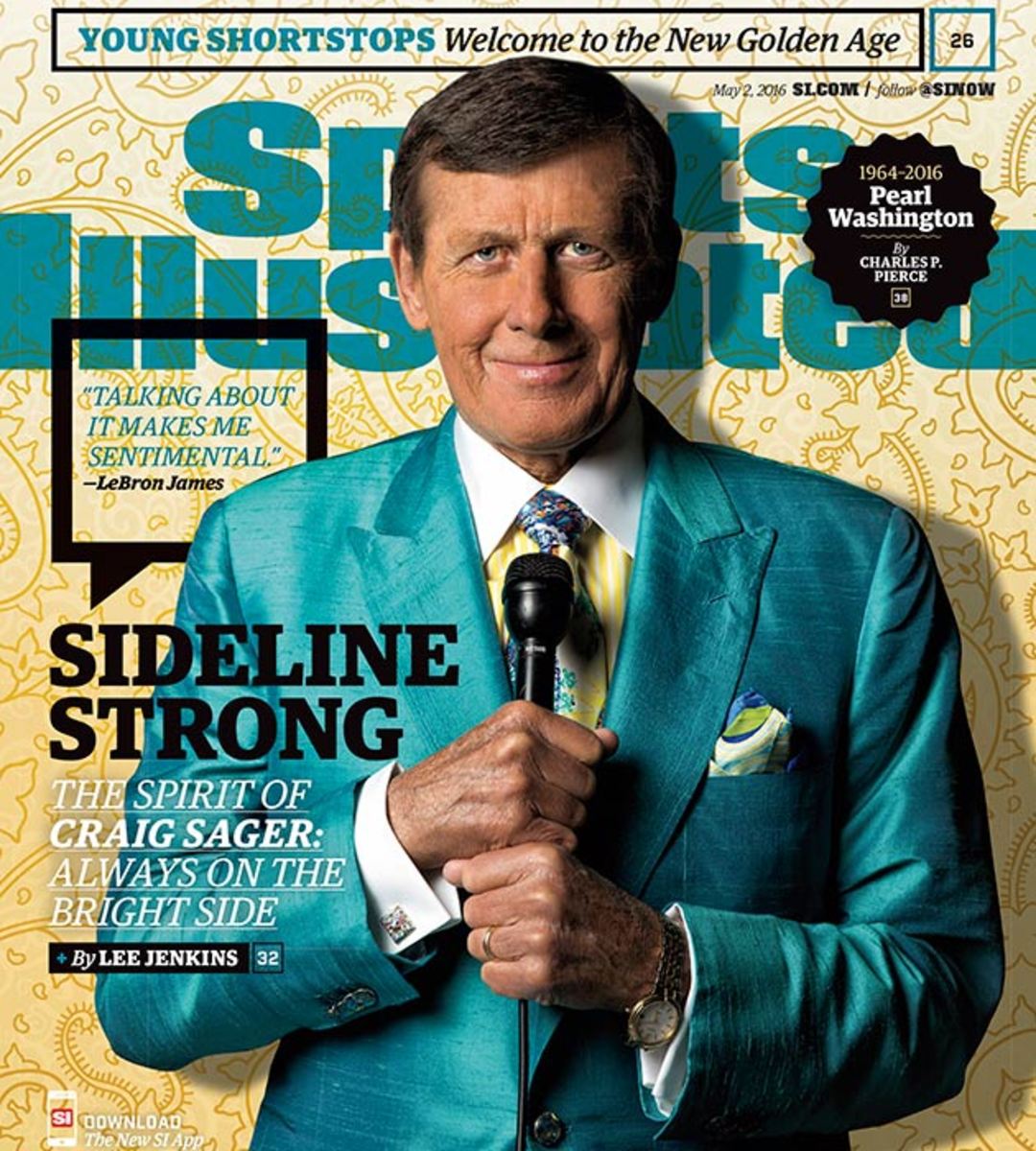
For a long time you probably just knew him for the clothes, bold threads connecting a colorful life. Boys at Batavia (Ill.) High were required to wear black or navy blazers for their graduation pictures. Sager showed up in an electric blue Nehru jacket, confounding the photographer. He was an athlete before he was a dandy, a walk-on football and basketball player at Northwestern who sustained two concussions returning kicks in his first fall camp, sending him to the cheerleading squad instead. Using his mini-trampoline, he did flips over cars during pub crawls. But cheerleaders didn’t travel, and Sager longed for the road, so he dressed as Willie the Wildcat for a showdown at Ohio State. After Northwestern won, the Buckeyes’ band took out its frustrations on poor Willie, stabbing his mascot fur with their instruments. The Cats sprinted from a victorious locker room to rescue Sager, making him Willie for good.
After graduating in 1973 with a degree in speech, Sager moved to Sarasota, Fla., where he worked as a sailing instructor, a bouncer at Big Daddy’s and a cub reporter at a radio station. A memorable audition tape—he rocked a blue-and-yellow seersucker suit—landed him on TV as a weatherman. From Tampa to Turner, execs tried to whitewash his wardrobe, going so far as to airbrush the bright hues from his jackets in promotional photos. Finally, they found a beat that could embrace his peacock sensibilities: the NBA. Alas, Kevin Garnett compared him to a Christmas ornament, Phil Jackson to the Good Humor Man, Charles Barkley to a pimp. He was heckled mercilessly. “There’s no way you bought that piece of s--- in Philadelphia!” one fan shouted in the City of Brotherly Love. Sager raised the garment bag from Boyds as proof.
“I put in a dress code for the players, but I should have put one in for the broadcasters too,” former commissioner David Stern once chided. At the 2001 All-Star Game in Washington, Stern commanded Sager to remove his double silk metallic silver Versace suit because it was reflecting arena lights. Not long after, at Madison Square Garden, Stern flashed Sager another dirty look for another outrageous getup. “Aw, he looks so nice tonight,” said Stern’s wife, Dianne. “He’s lively and fun, and isn’t that how sports are supposed to be?”
Sager is not the guy who provides dissertations on pick-and-roll defense. He is the guy who once slept next to the stall of Seattle Slew the night before the horse won the Triple Crown, who bailed Morganna the Kissing Bandit out of jail, who surprised Shaquille O’Neal by boat at his Isleworth home. An interview with Sager should really be conducted at the dog track, where he used to own greyhounds, or a Hooters, where servers clad in Sager Orange bring him Bud Light and buffalo shrimp. He should be perched on a barstool next to his wife, Stacy—a former Bulls dancer 21 years his junior—regaling strangers with a story about Dennis Rodman, who went AWOL from the Pistons in 1993 and planned to commit suicide, until Sager tracked down the Worm on the second floor of a Detroit strip club. “The Landing Strip,” Sager recalls. “He had the gun. He was going to do it. I told him how stupid that would be.”
But he can’t go to Hooters right now. He is waiting on a phone call, and as he admires the gold crystals in his tie, he is interrupted by a shrill ring. “I think that’s the doctor,” Sager says. He excuses himself to the living room of the Park Suite and picks up. “What are my platelets today? They’re four today? O.K. What’s normal? 140? O.K. No, it doesn’t surprise me. I understand. I’m fine. I feel good. Don’t worry. I’m used to this.” He hangs up. “My platelets are at four!” he announces, with a grim laugh. “If I got cut right now I could bleed to death.”
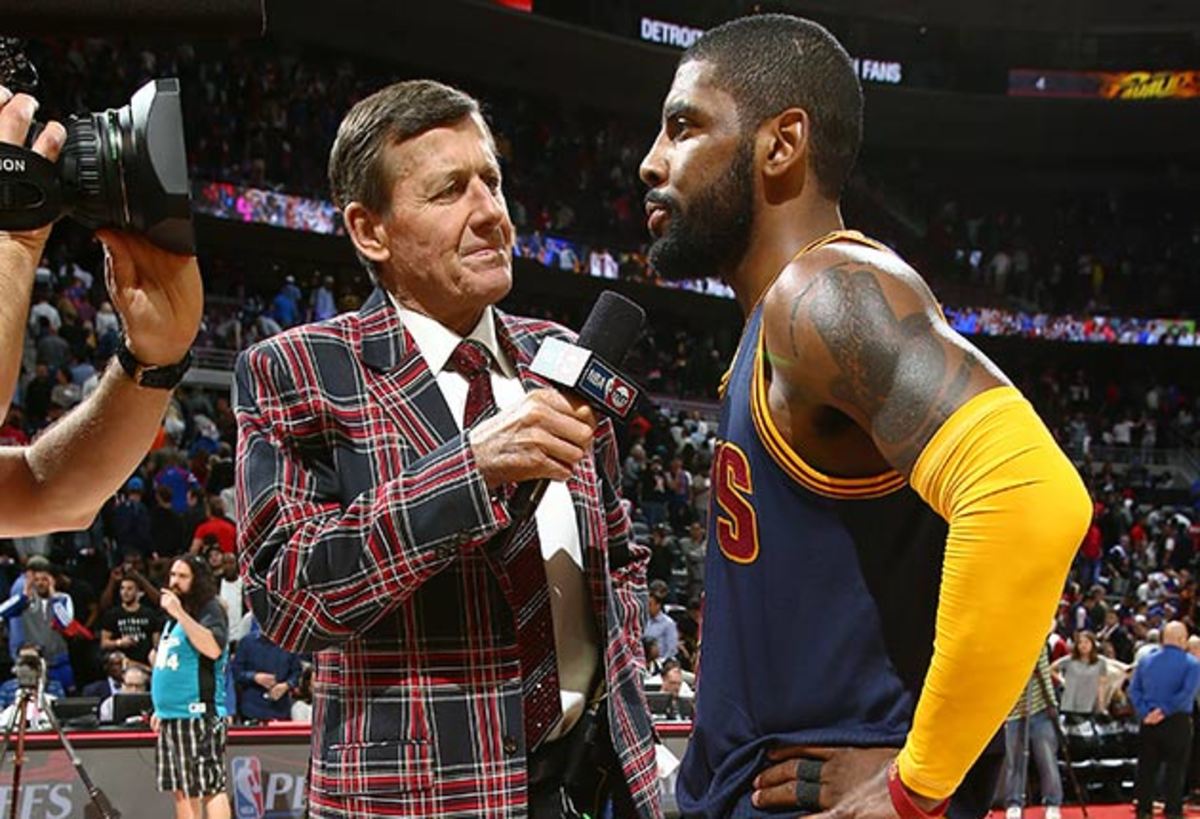
Sager steps out of his producer’s rented Impala and ambles into The Palace for Game 3. He is wearing the lilac jacket, the purple pants, the striped shirt, the zigzag tie. “For Prince,” he says, as if the outfit wasn’t planned weeks ago. While he makes his way to the court, a receiving line forms around him: security guards, building workers, ushers. Local TV reporters who say they idolize him. Fans who say they pray for him. Cavaliers guard J.R. Smith daps him up. So does Pistons center Aron Baynes. Christine Cameron, the mother of Detroit center Andre Drummond, hugs him and holds on for a few extra seconds. He signs about 100 autographs. “Whenever Craig Sager is covering your game, you know it’s a big one,” says Cavs forward LeBron James. “But when I look over and see him covering our game right now. . . .” His voice tails off. “Talking about it makes me sentimental.”
NBA TV viewers watch Sager’s pregame stand-up, about a burgeoning feud between James and Pistons rookie Stanley Johnson, but they can’t possibly comprehend the hell he endured to step on this floor: chemotherapy treatments on Monday and Tuesday at MD Anderson Cancer Center in Houston. A game on Wednesday night in Cleveland, a flight on Thursday morning to Detroit, constant reminders from Stacy to wear his surgical mask on the plane, wash his hands, take his 20 pills from the color-coded box. Lab work on Thursday afternoon at Detroit Medical Center—“The doctors looked at my numbers and freaked out!” Sager howls—prompting a platelet transfusion that night at Sinai-Grace Hospital.
He lay on a bed at Sinai too small for his 6' 4" frame, legs dangling off the end, a yellow IV bag attached to his left arm. He scrounged up a burger and a salad for dinner. “I don’t have a TV here,” he said over the phone. “What are the scores?” Doctors wanted to keep him overnight, but he protested, so they released him at 1:30 a.m. Sixteen hours later he was at The Palace, declaring himself dramatically improved. The new platelets had helped blood clotting in his mouth, on his face and on his hands. “If I didn’t agree to do that I might not make it through the weekend,” Sager says. “It’s keeping me alive.” He typically requires two transfusions per week.
Gallery: Craig Sager's wildest suits over the years
Craig Sager's Wildest Suits
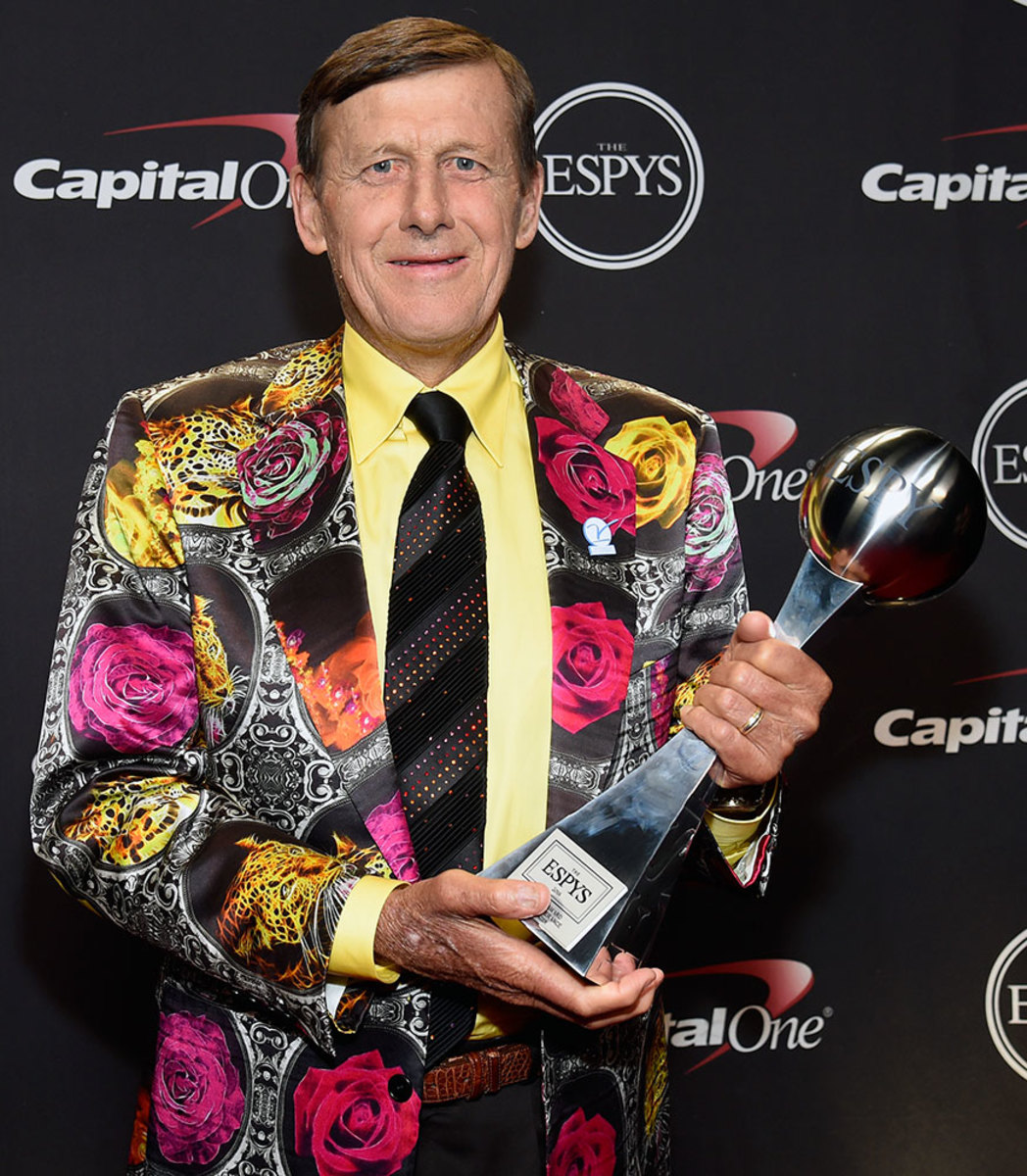
Craig Sager poses with the Jimmy V Perseverance Award at the 2016 ESPYS on July 13, 2016 at Microsoft Theater in Los Angeles.
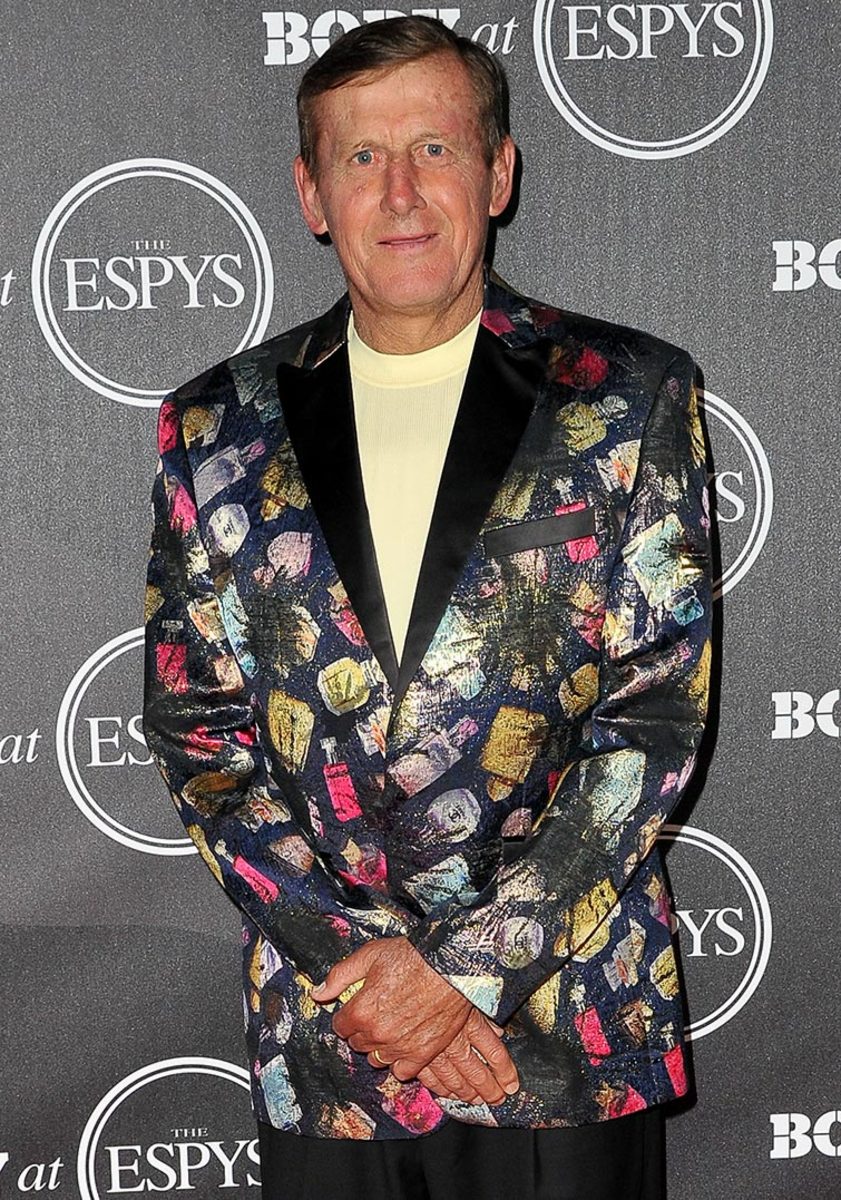
Craig Sager attends BODY At The ESPYs Pre-Party on July 12, 2016 at Avalon Hollywood in Los Angeles.
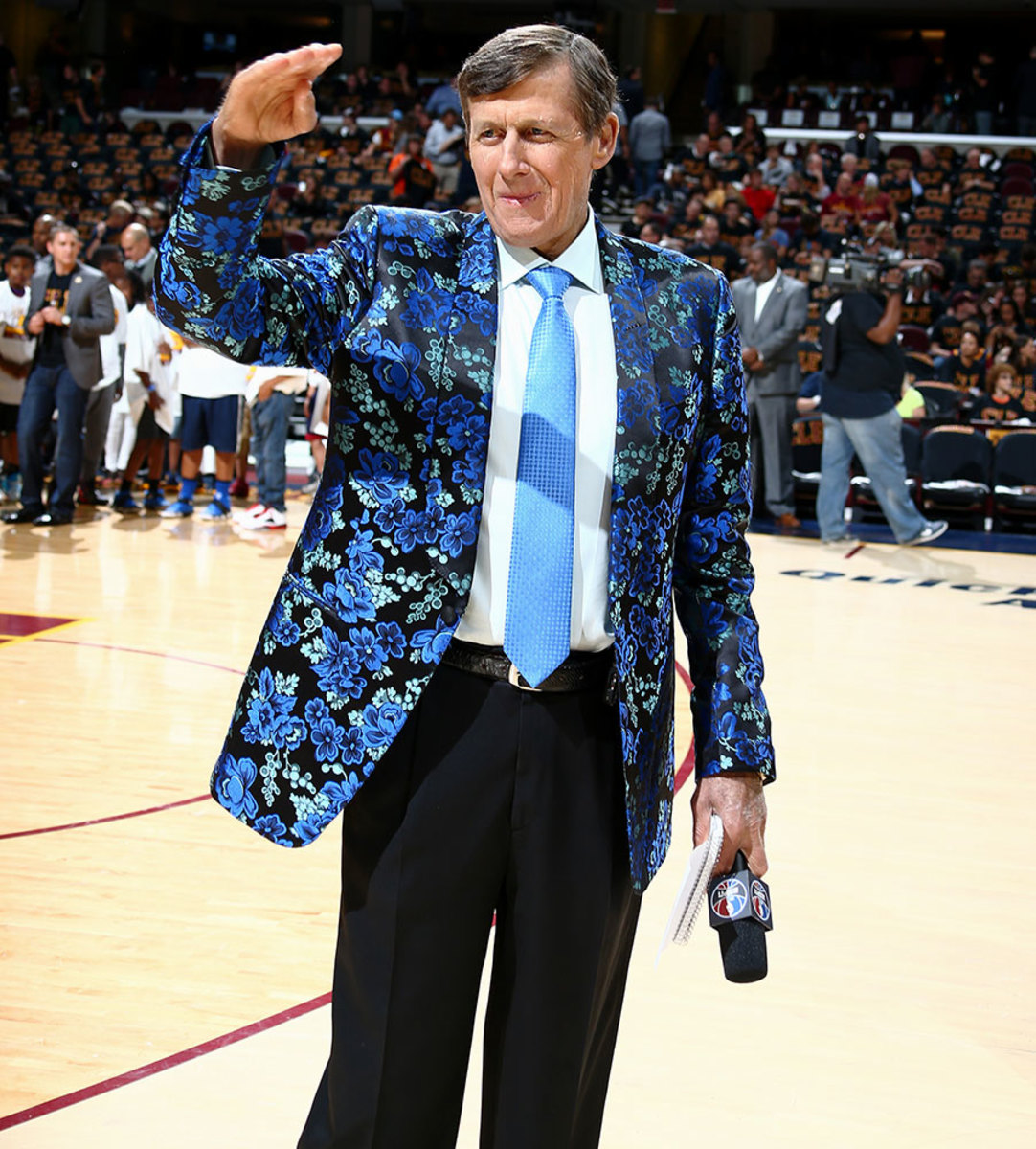
Craig Sager salutes fans before Game Six of the NBA Finals between the Cleveland Cavaliers and Golden State Warriors on June 16, 2016 at Quicken Loans Arena in Cleveland.
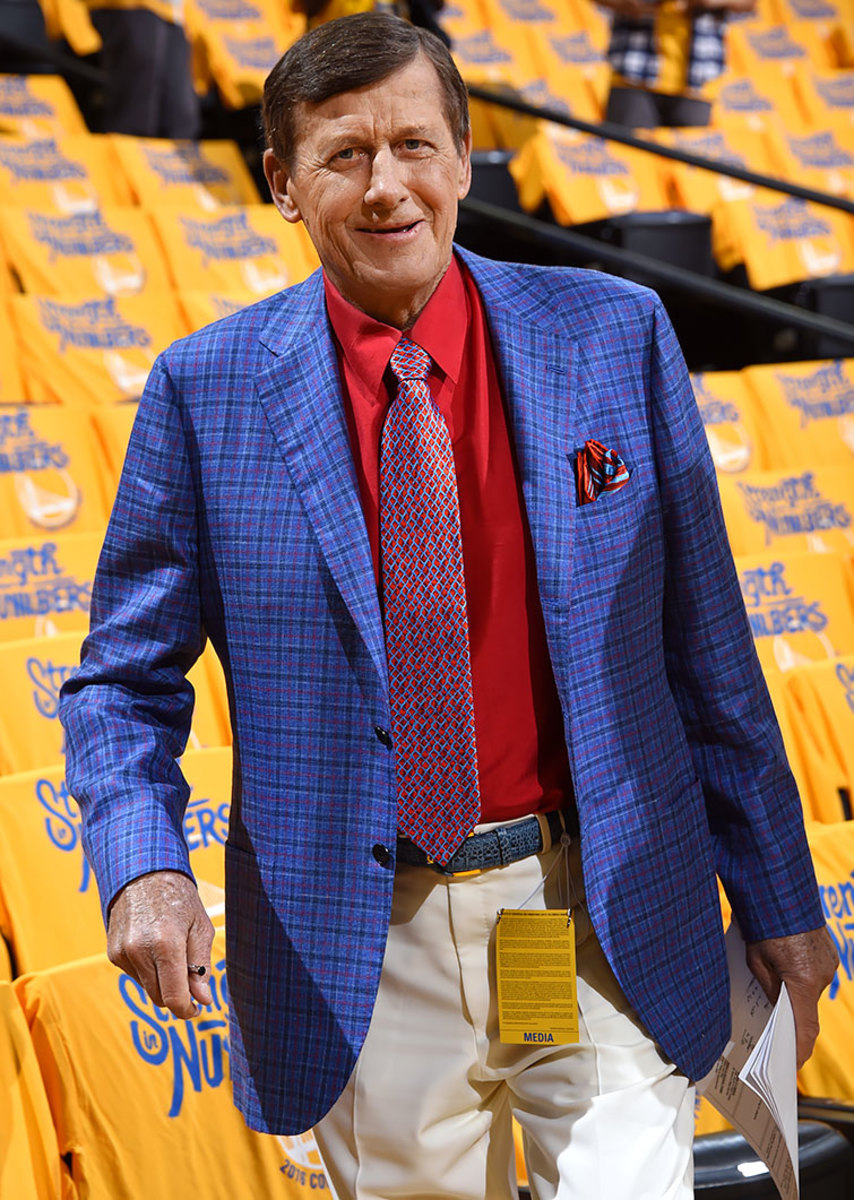
Craig Sager looks on before Game Seven of the Western Conference Finals between the Golden State Warriors and Oklahoma City Thunder on May 26, 2016 at Oracle Arena in Oakland.
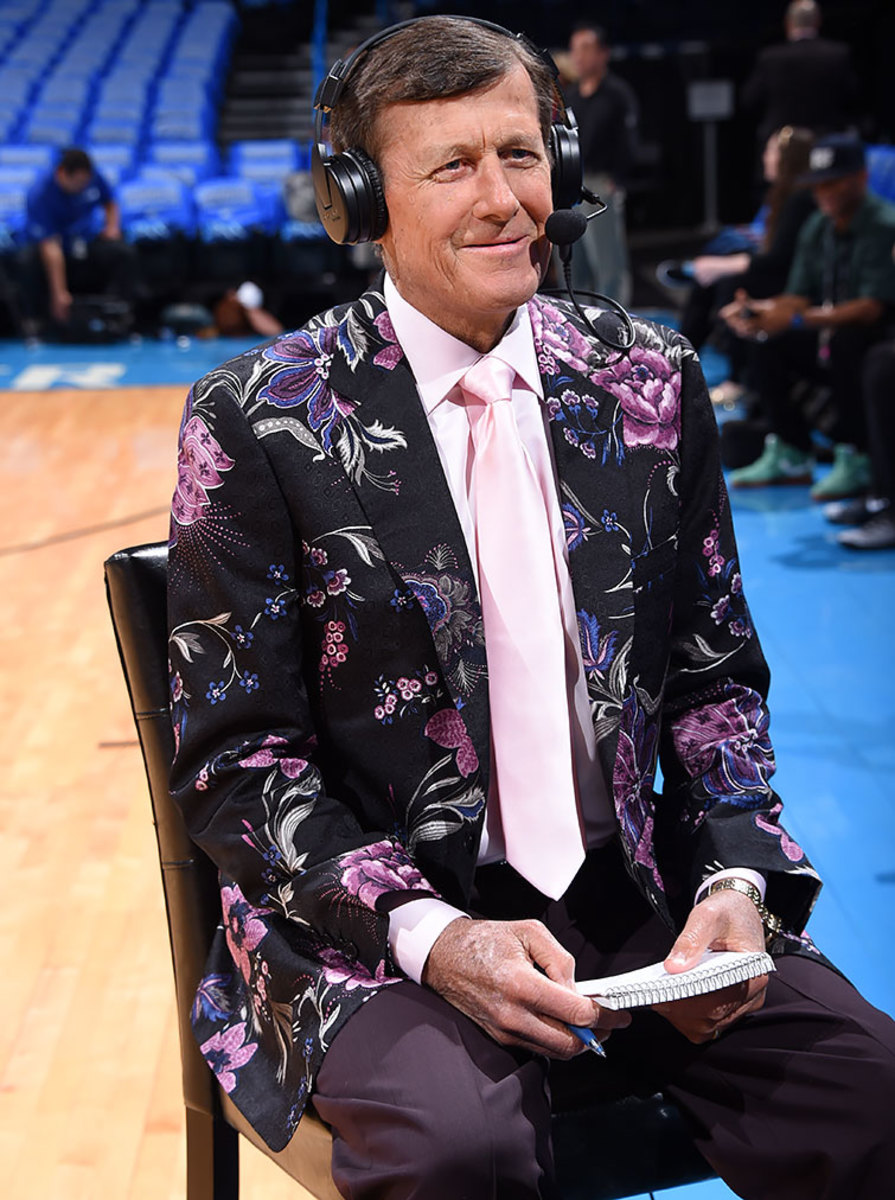
Craig Sager looks on before Game Six of the Western Conference Finals between the Oklahoma City Thunder and Golden State Warriors on May 28, 2016 at Chesapeake Energy Arena in Oklahoma City.
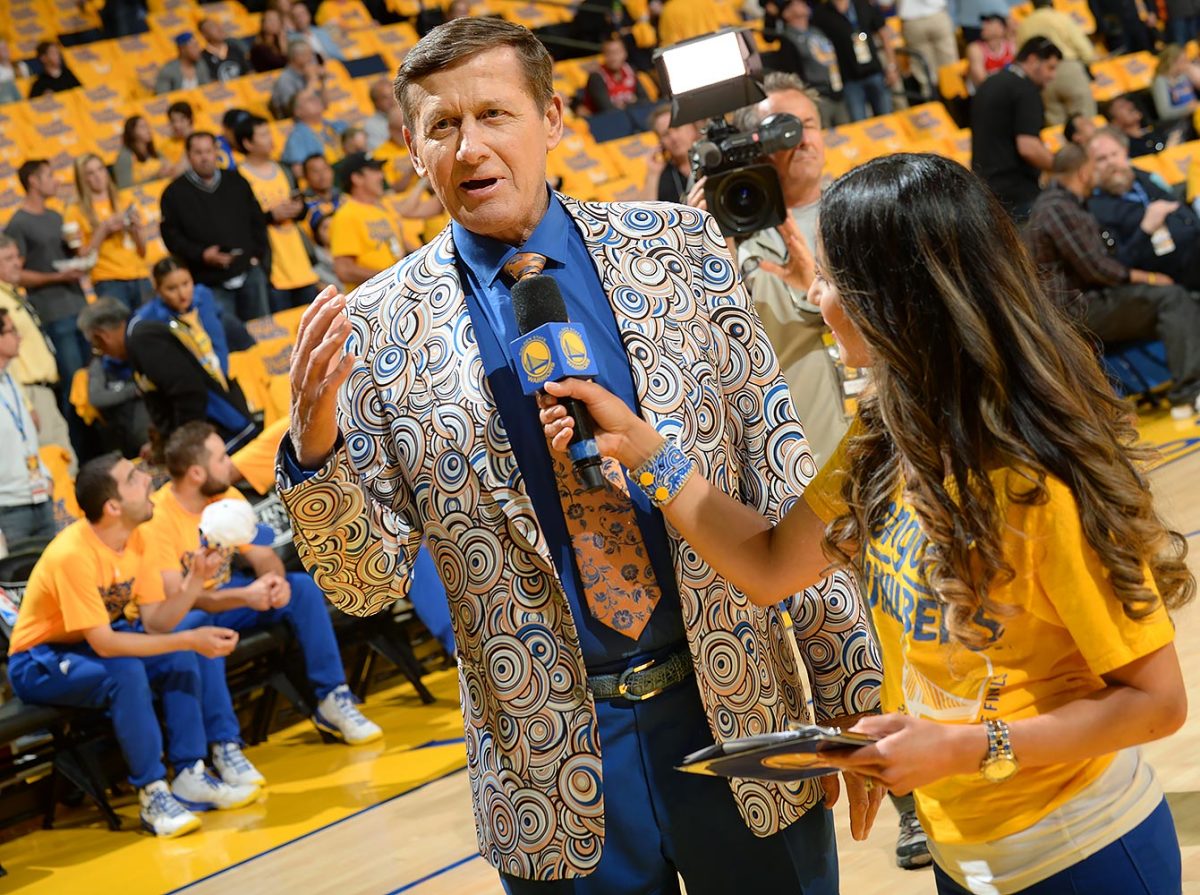
Craig Sager is interviewed before Game Five of the Western Conference Finals between the Golden State Warriors and Oklahoma City Thunder on May 26, 2016 at Oracle Arena in Oakland.
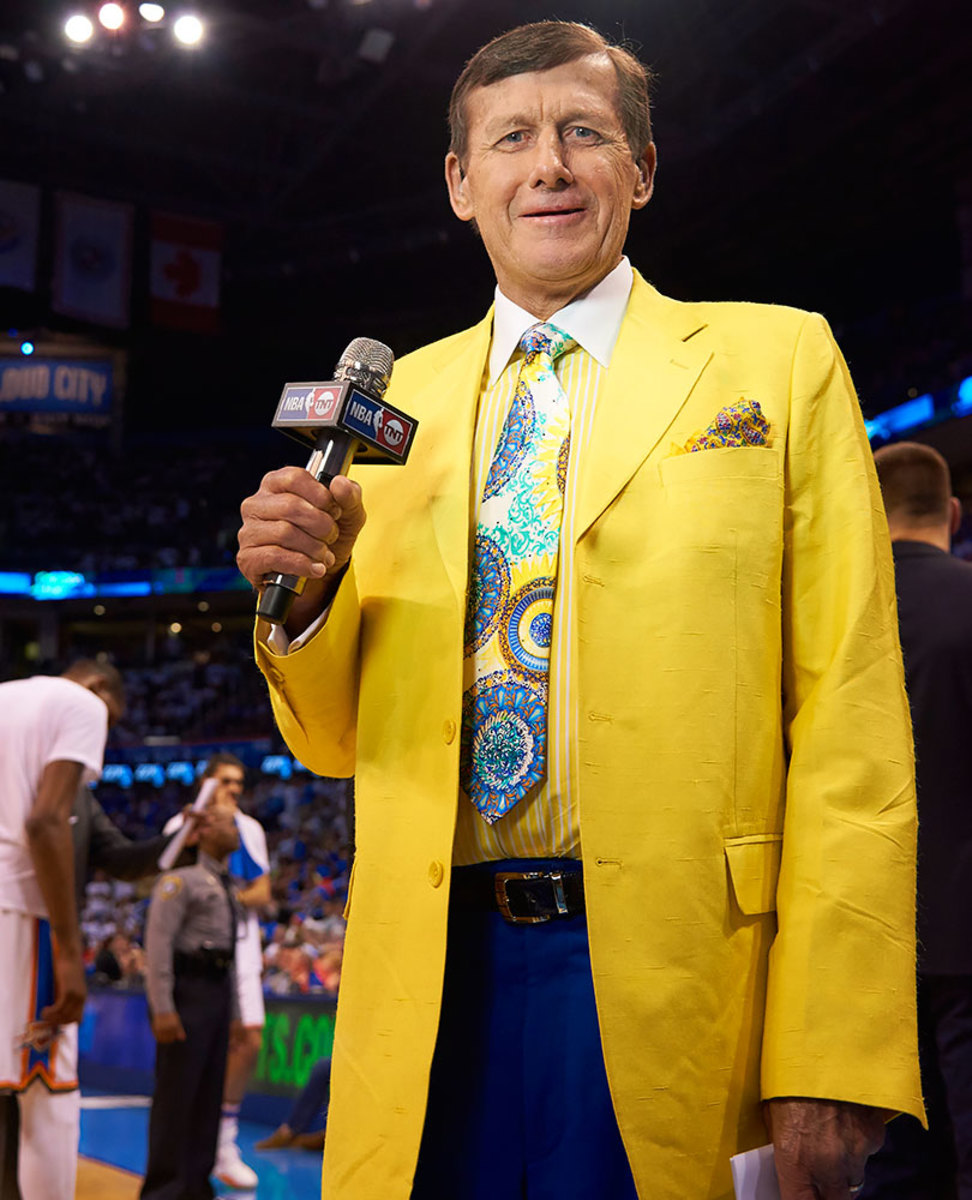
Craig Sager looks on during Game Three of the Western Conference Finals between the Oklahoma City Thunder and Golden State Warriors on May 22, 2016 at Chesapeake Energy Arena in Oklahoma City.
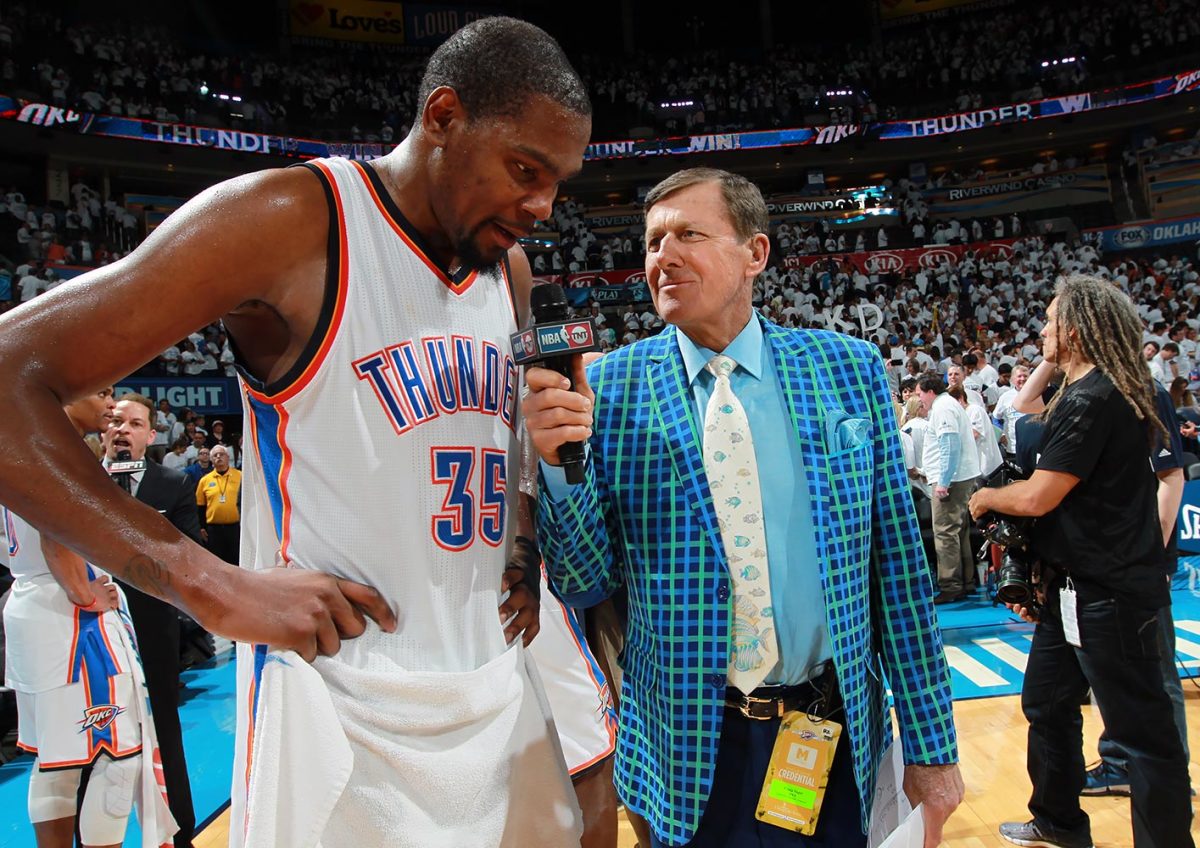
Craig Sager interviews Kevin Durant following the Oklahoma City Thunder win over the San Antonio Spurs in Game Four of the Western Conference Semifinals on May 8, 2016 at Chesapeake Energy Arena in Oklahoma City.
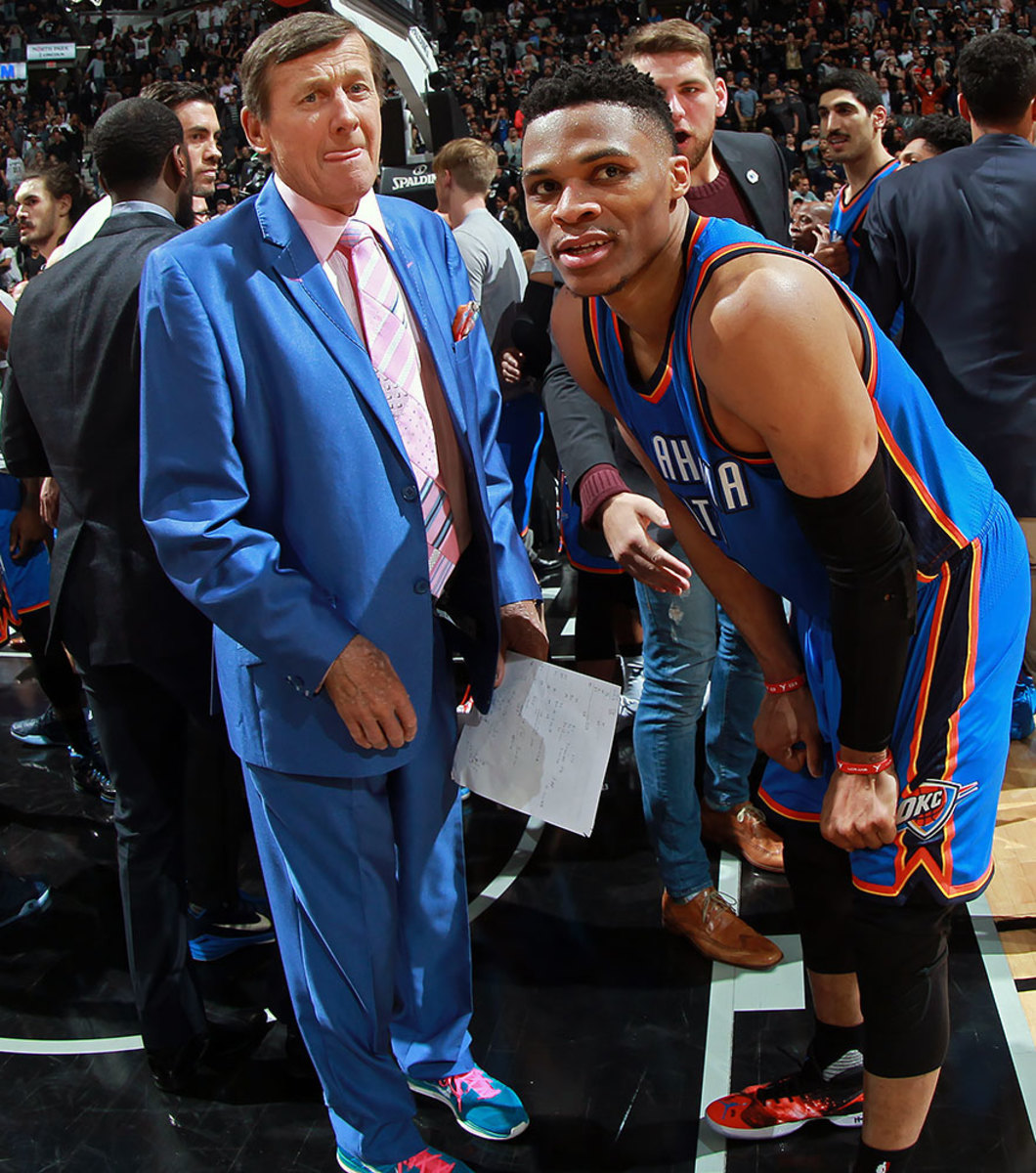
Craig Sager waits to interview Russell Westbrook following the Oklahoma City Thunder win over the San Antonio Spurs in Game Two of the Western Conference Semifinals on May 2, 2016 at the AT&T Center in San Antonio.
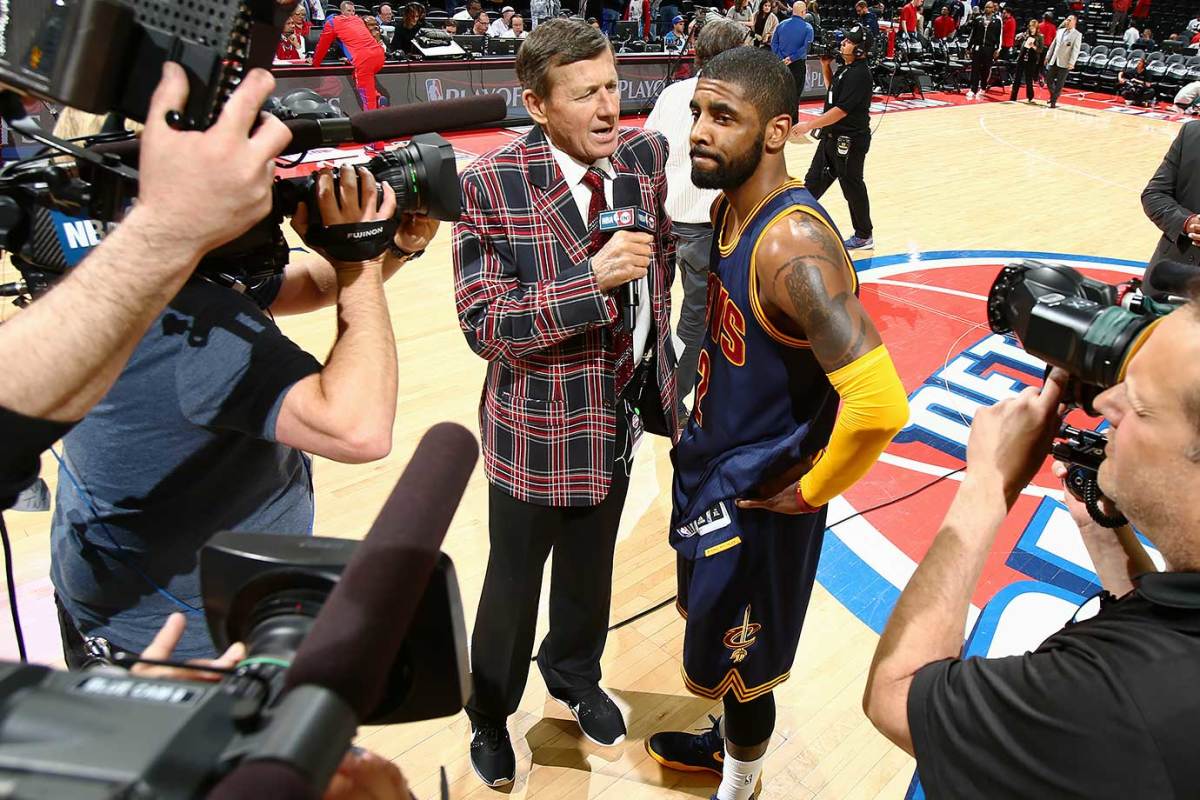
Craig Sager interviews Kyrie Irving following the Cleveland Cavaliers win over the Detroit Pistons in Game Four of the Eastern Conference First Round on April 24, 2016 at Quicken Loans Arena in Cleveland.
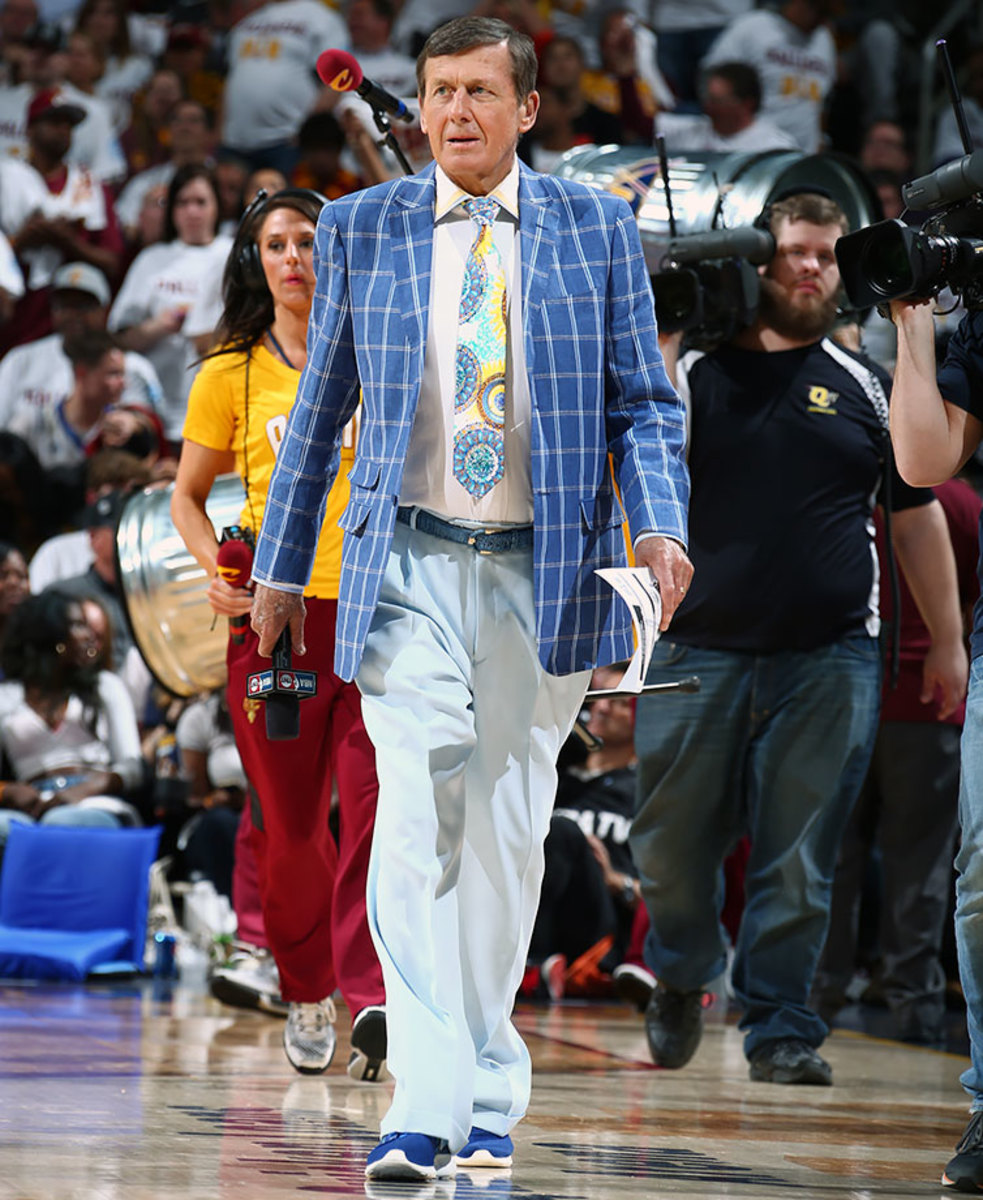
Craig Sager looks on during Game Two of the Eastern Conference First Round between the Cleveland Cavaliers and Detroit Pistons on April 20, 2016 at Quicken Loans Arena in Cleveland.
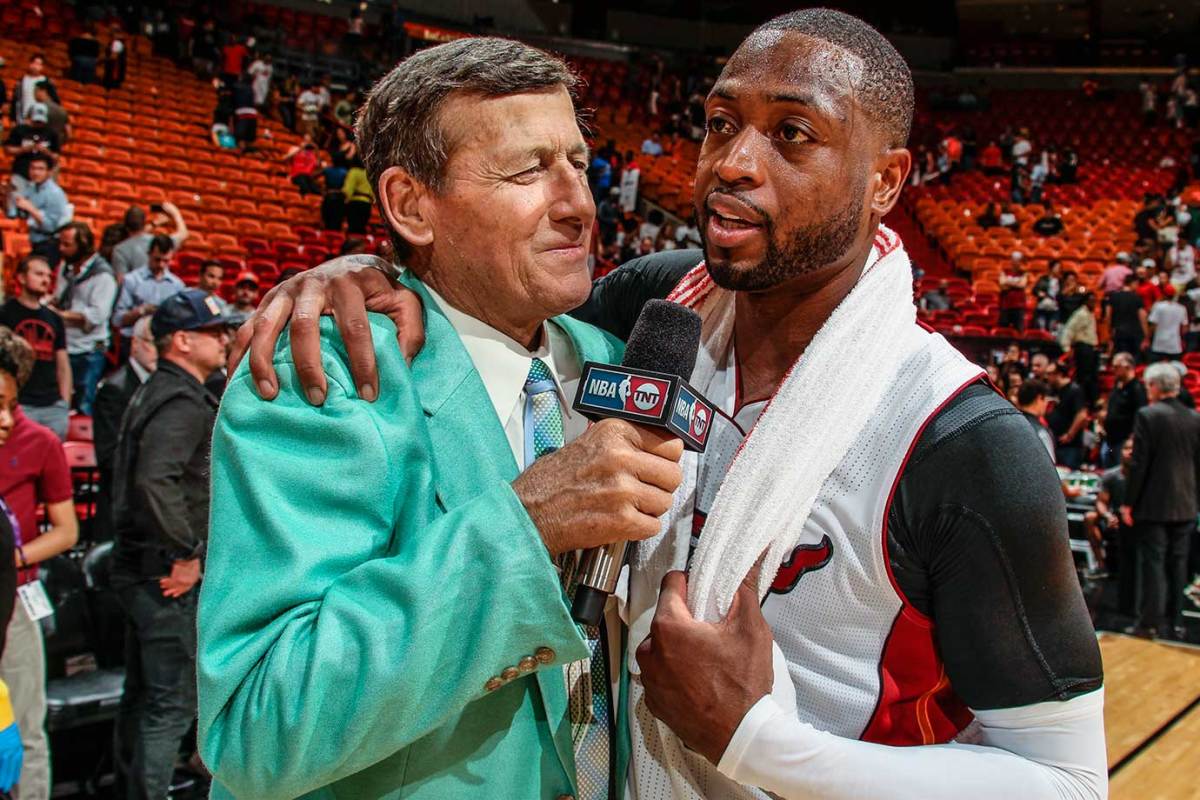
Craig Sager interviews Dwyane Wade following the Miami Heat's win over the Chicago Bulls on April 7, 2016 at AmericanAirlines Arena in Miami.
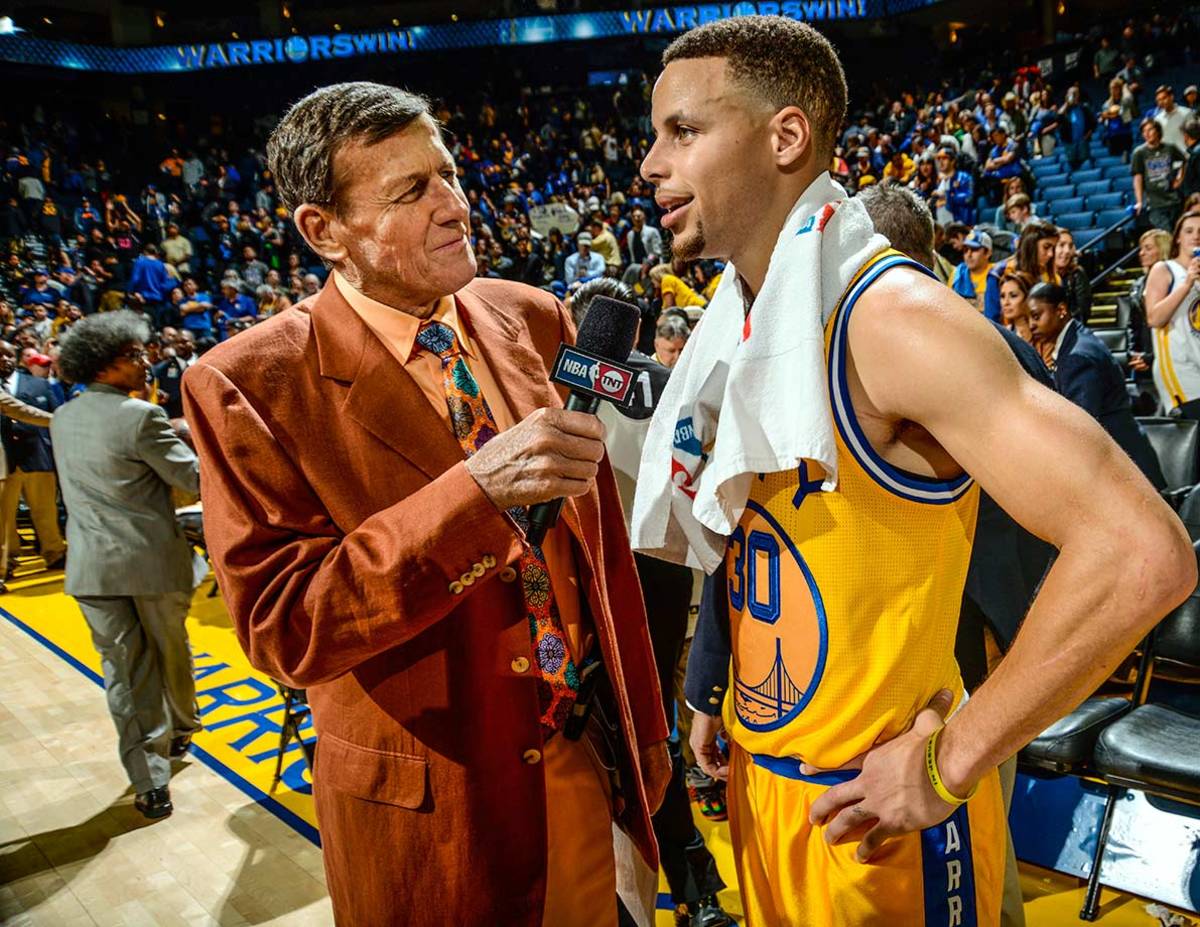
Craig Sager interviews Stephen Curry following the Golden State Warriors win over the Washington Wizards on March 29, 2016 at Oracle Arena in Oakland.
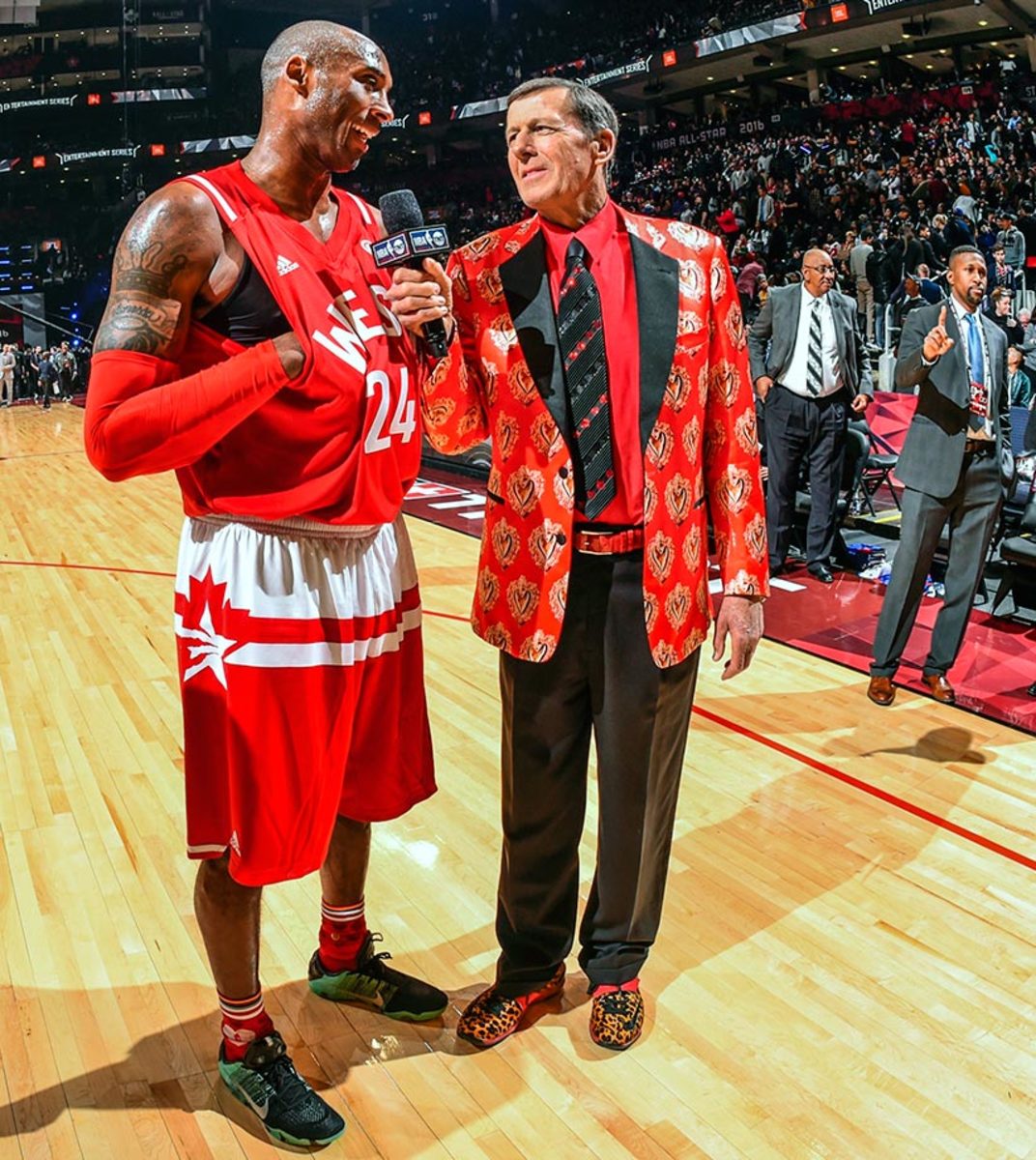
Craig Sager interviews Kobe Bryant during the NBA All-Star Game on Feb. 14, 2016 at the Air Canada Centre in Toronto.
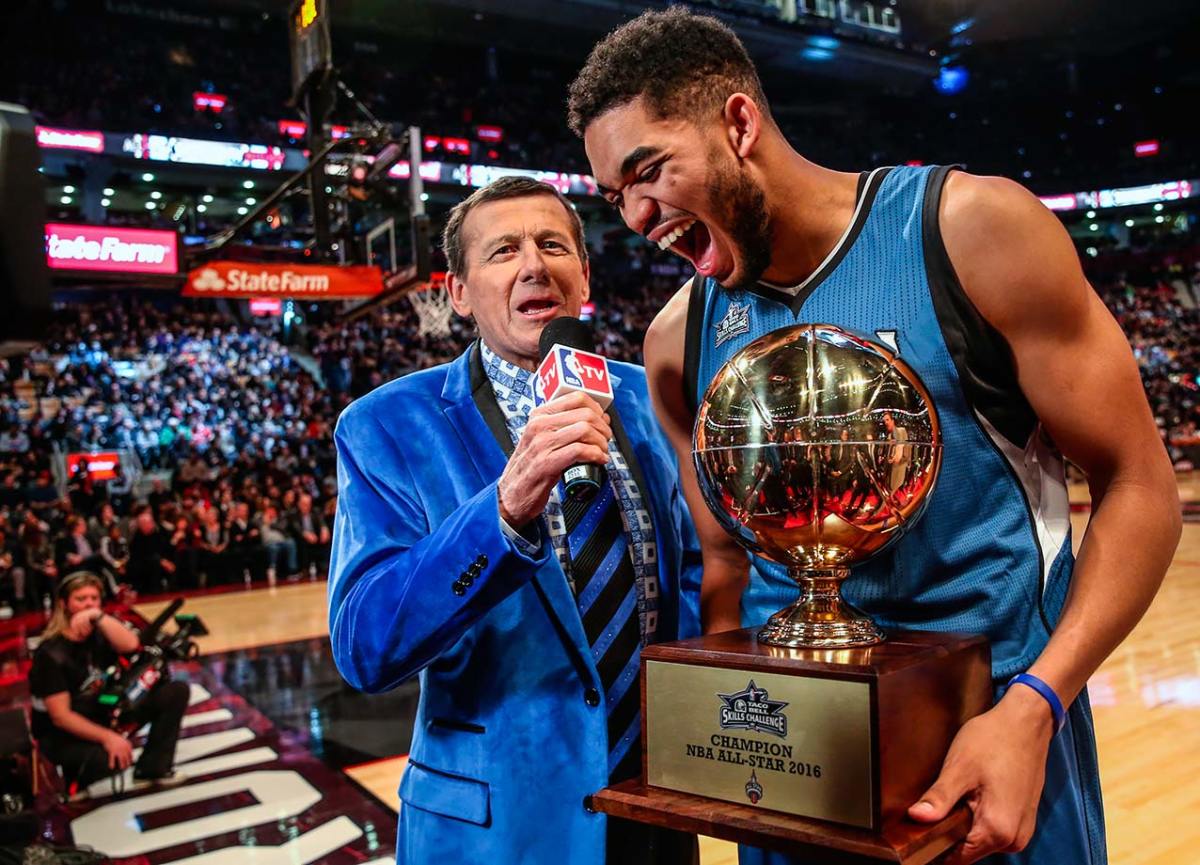
Craig Sager interviews Karl-Anthony Towns after he received the Skills Challenge award as part of NBA All-Star Weekend on Feb. 13, 2016 at Air Canada Centre in Toronto.
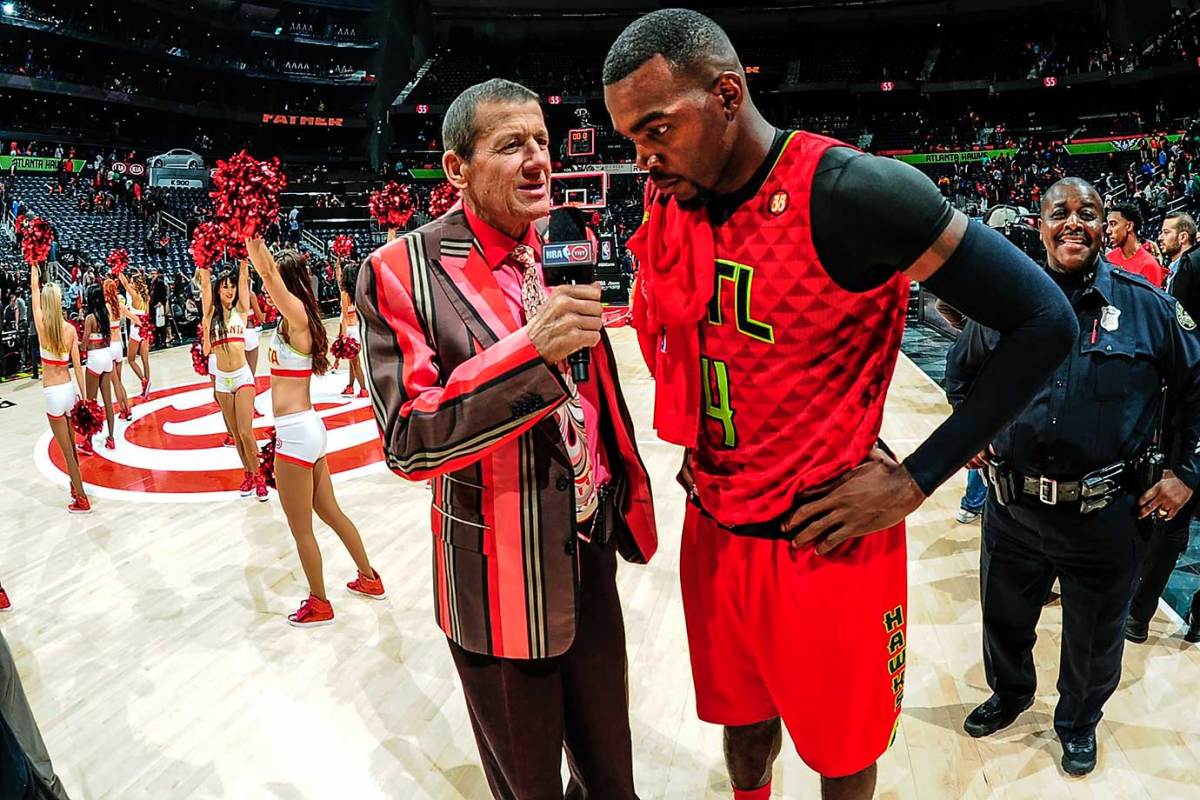
Craig Sager interviews Paul Millsap following the Atlanta Hawks win over the Boston Celtics on Nov. 24, 2015 at Philips Arena in Atlanta.
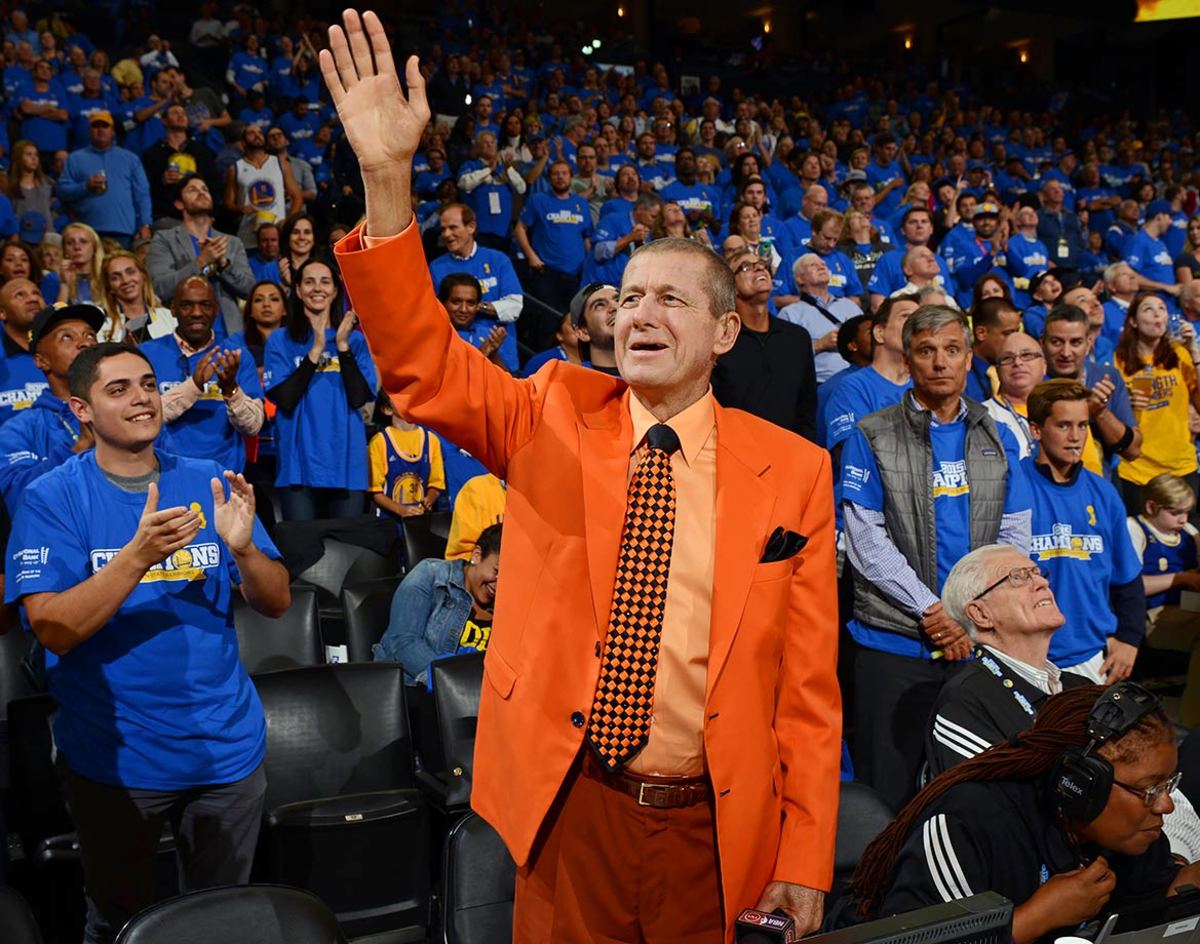
Craig Sager waves to the crowd before the Golden State Warriors game against the New Orleans Pelicans on Oct. 27, 2015 at ORACLE Arena in Oakland.
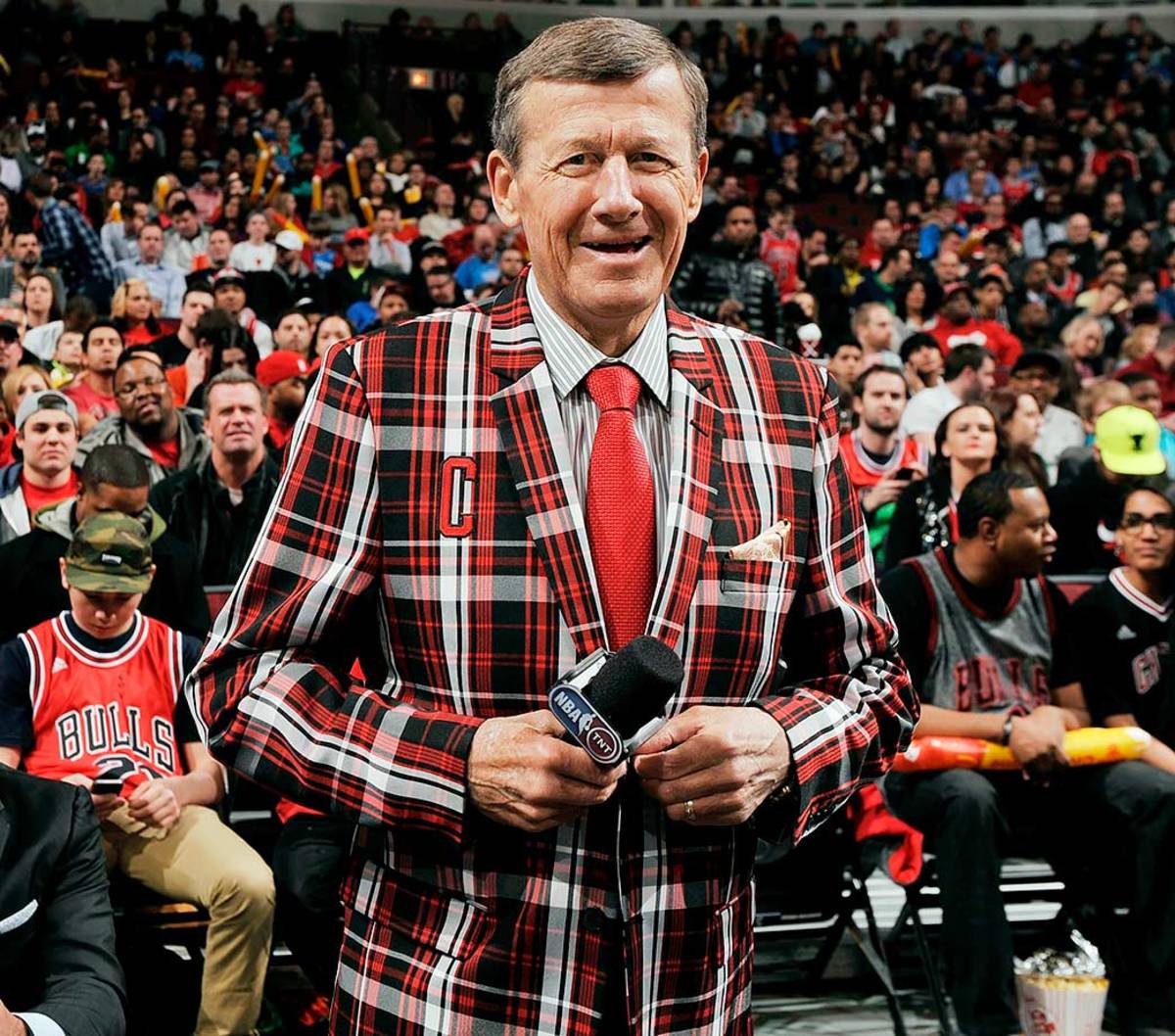
Craig Sager smiles during a game between the Chicago Bulls and Oklahoma City Thunder on March 5, 2015 at the United Center in Chicago.
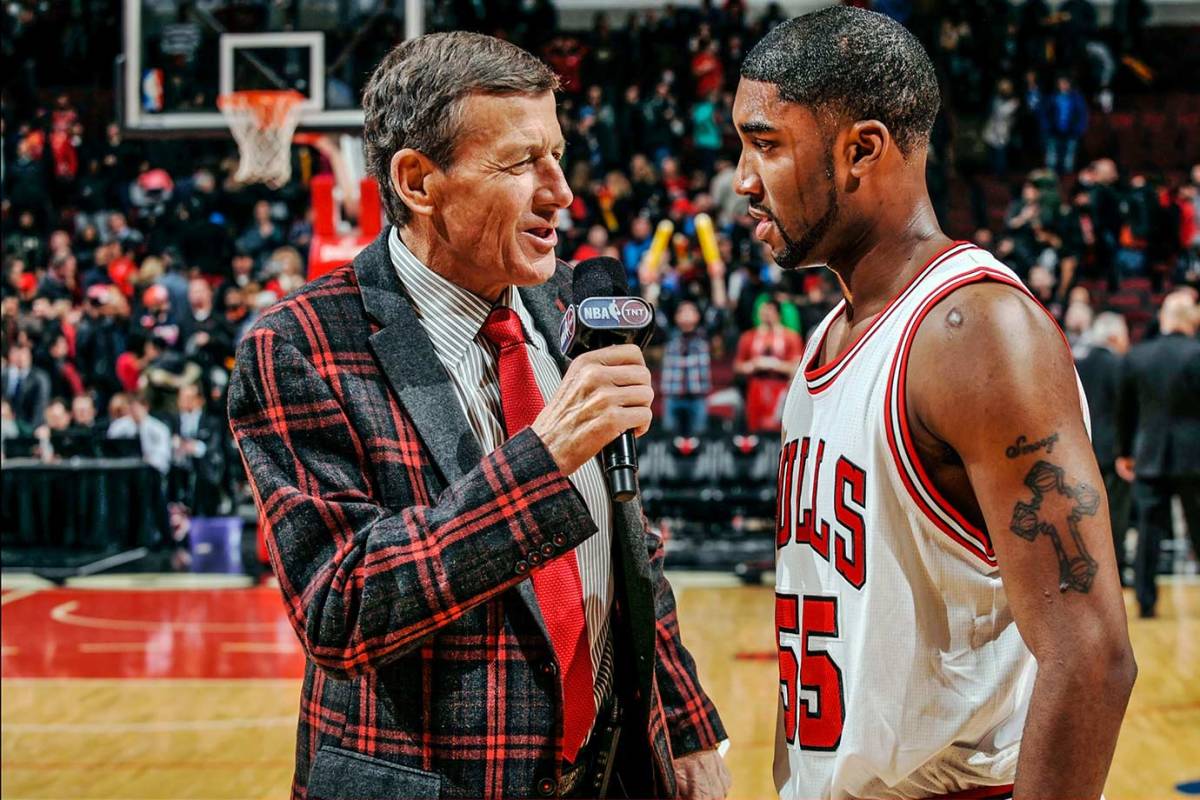
Craig Sager interviews E'Twaun Moore following the Chicago Bulls win over the Oklahoma City Thunder on March 5, 2015 at the United Center in Chicago.
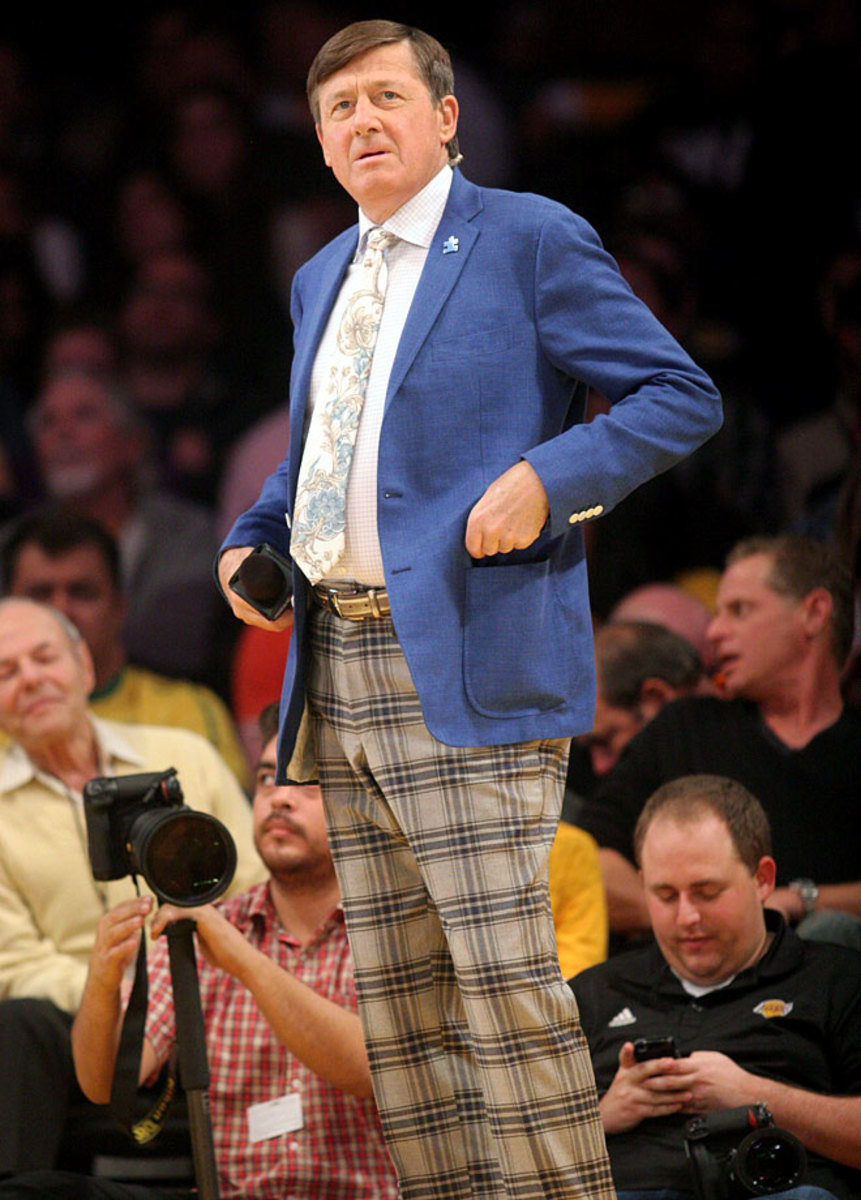
Craig Sager looks on during the Los Angeles Lakers game against the Portland Trail Blazers on April 1, 2014 at Staples Center in Los Angeles.
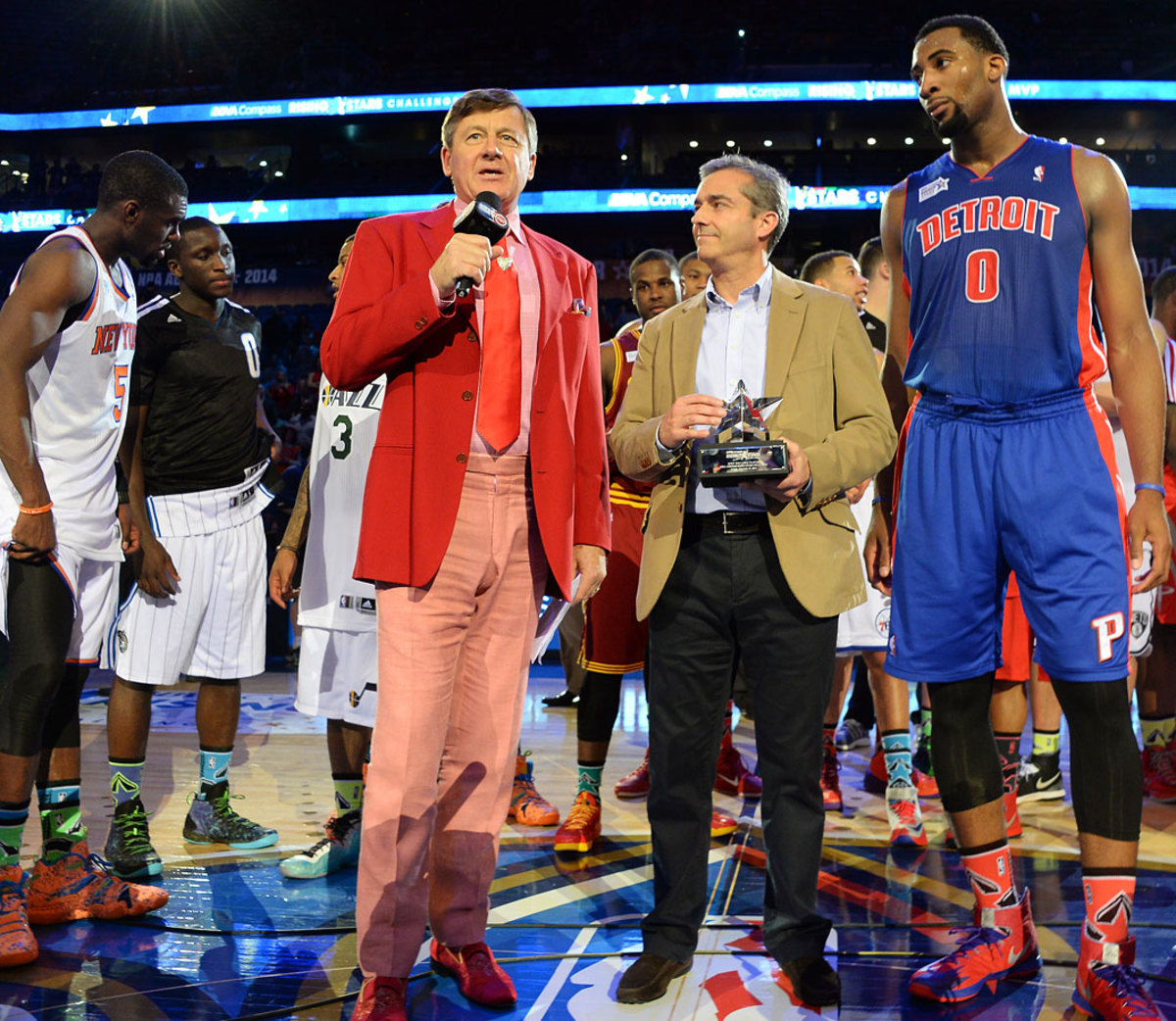
Craig Sager interviews BBVA President and COO Ángel Cano and Andre Drummond, awarded the MVP award for the Rising Stars Challenge part of NBA All-Star Weekend on Feb. 14, 2014 at the Smoothie King Center in New Orleans.
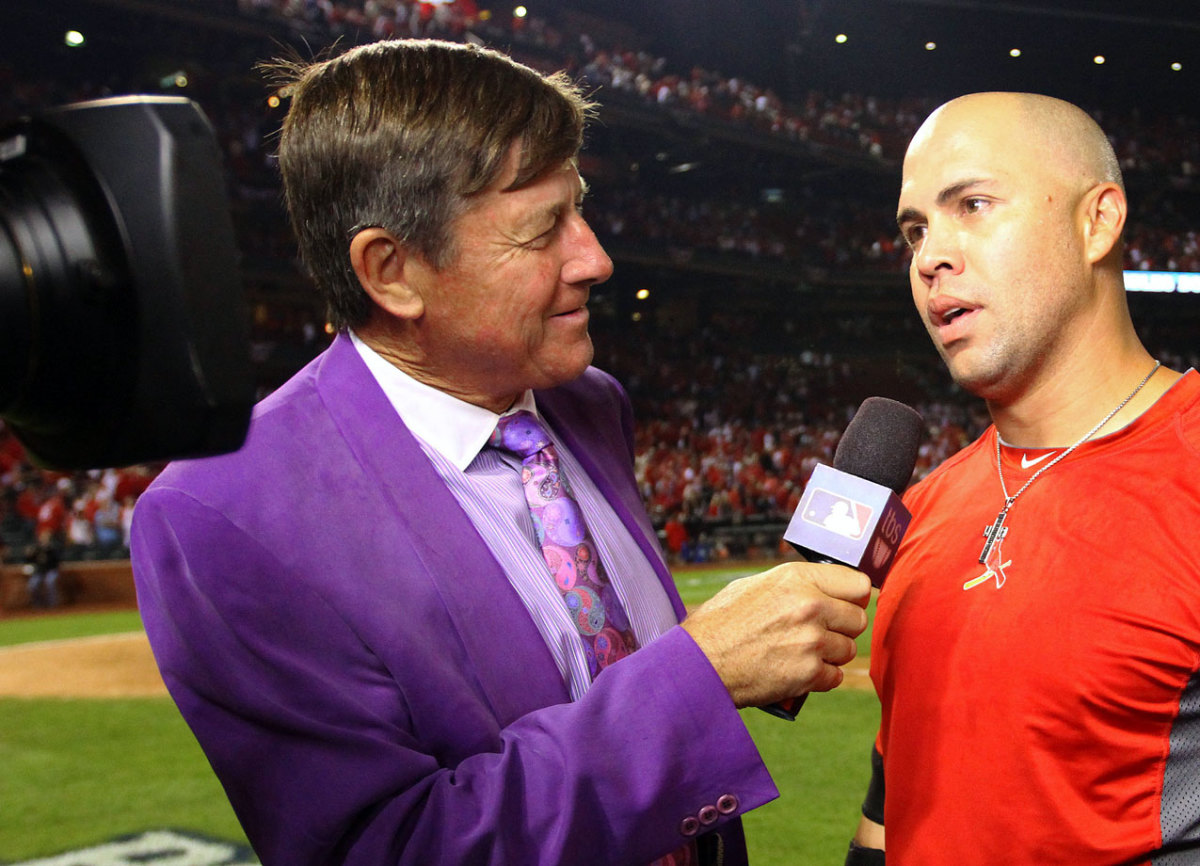
Craig Sager interviews Carlos Beltran following the St. Louis Cardinals win over the Los Angeles Dodgers in Game One of the National League Championship Series on Oct. 11, 2013 at Busch Stadium in St Louis.

Craig Sager looks on during Game Two of the National League Division Series between the Atlanta Braves and Los Angeles Dodgers on Oct. 4, 2013 at Turner Field in Atlanta.
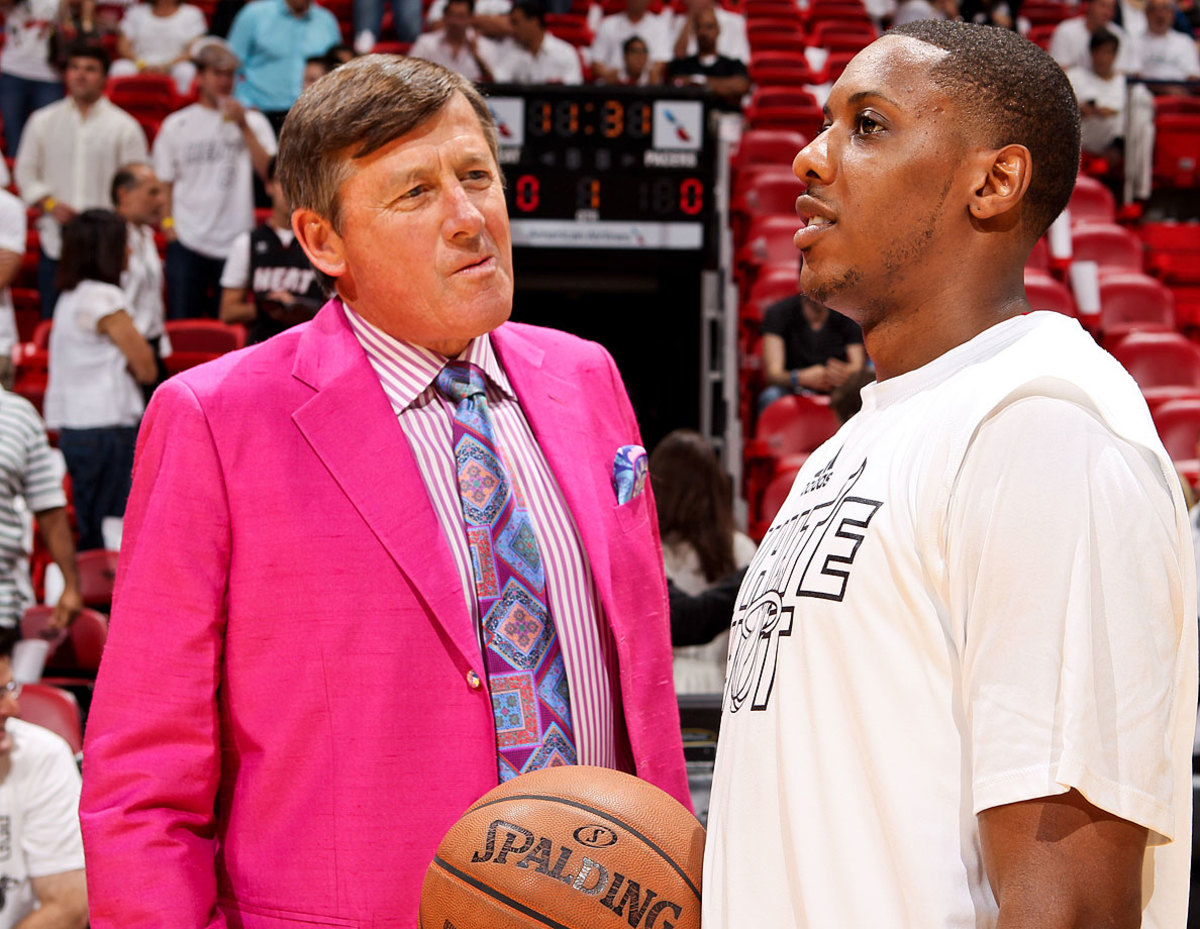
Craig Sager chats with Mario Chalmers before Game Five of the Eastern Conference Finals between the Miami Heat and Indiana Pacers on May 30, 2013 at AmericanAirlines Arena in Miami.
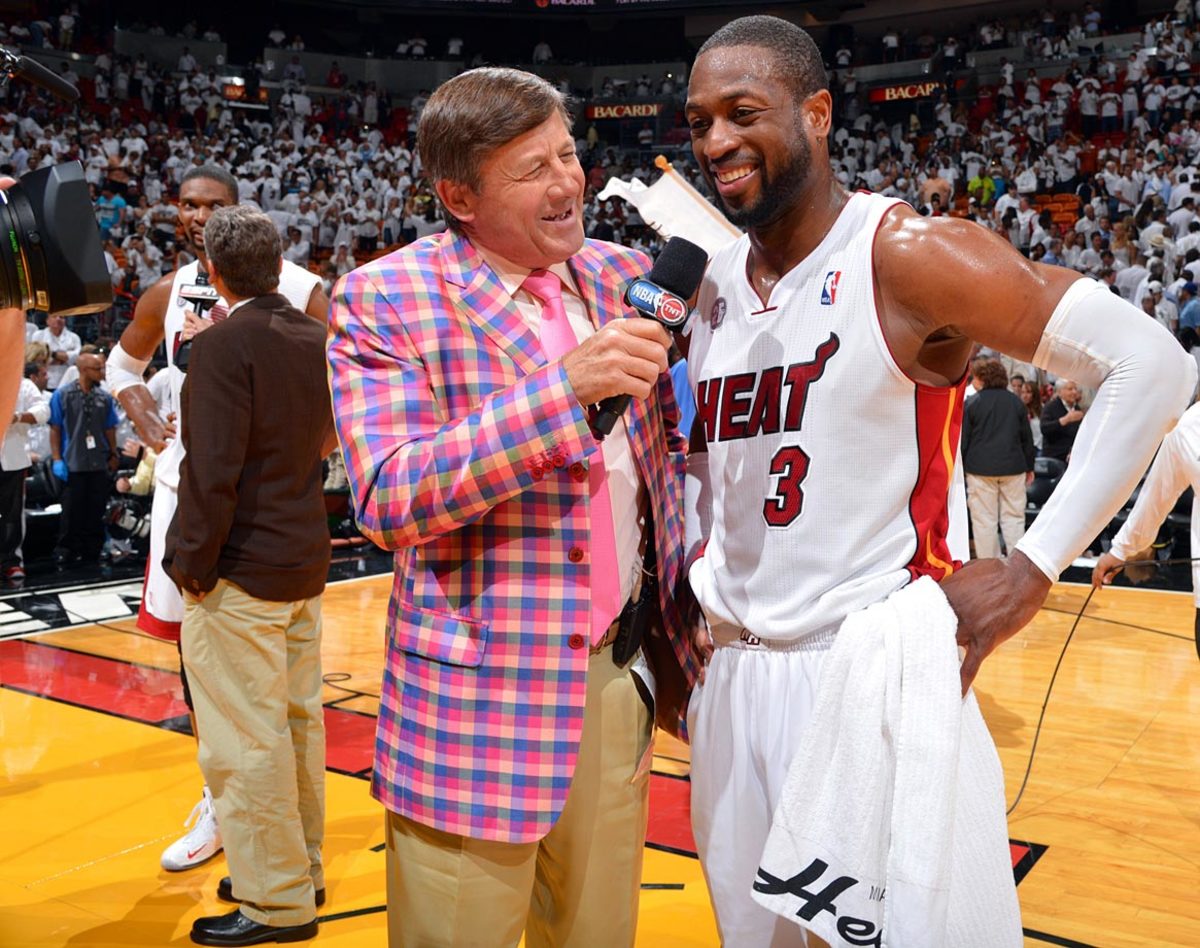
Craig Sager interviews Dwyane Wade following the Miami Heat's win over the Chicago Bulls in Game Five of the Eastern Conference Semifinals on May 15, 2013 at AmericanAirlines Arena in Miami.
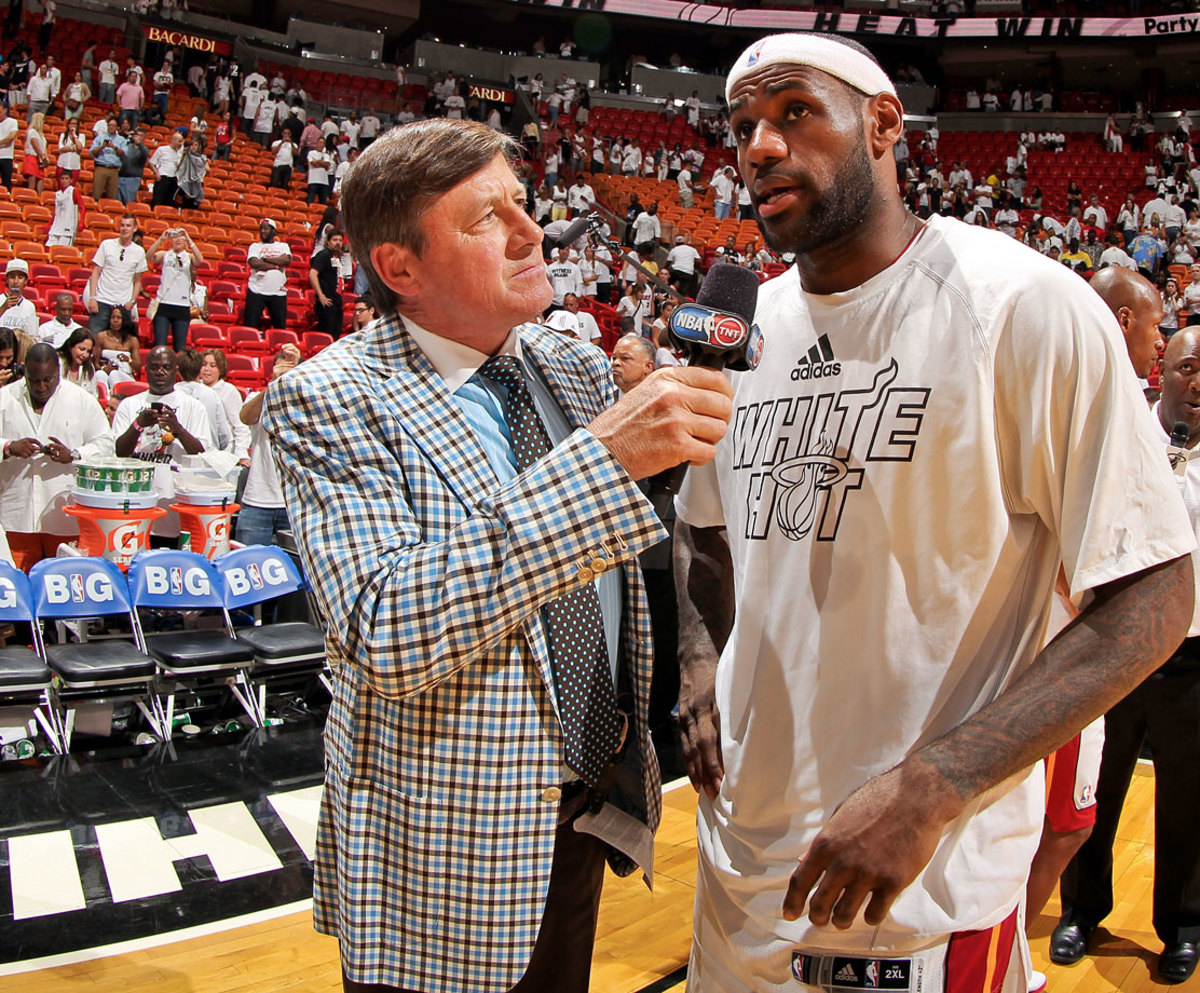
Craig Sager interviews LeBron James following the Miami Heat's win over the Chicago Bulls in Game Two of the Eastern Conference Semifinals on May 8, 2013 at AmericanAirlines Arena in Miami.
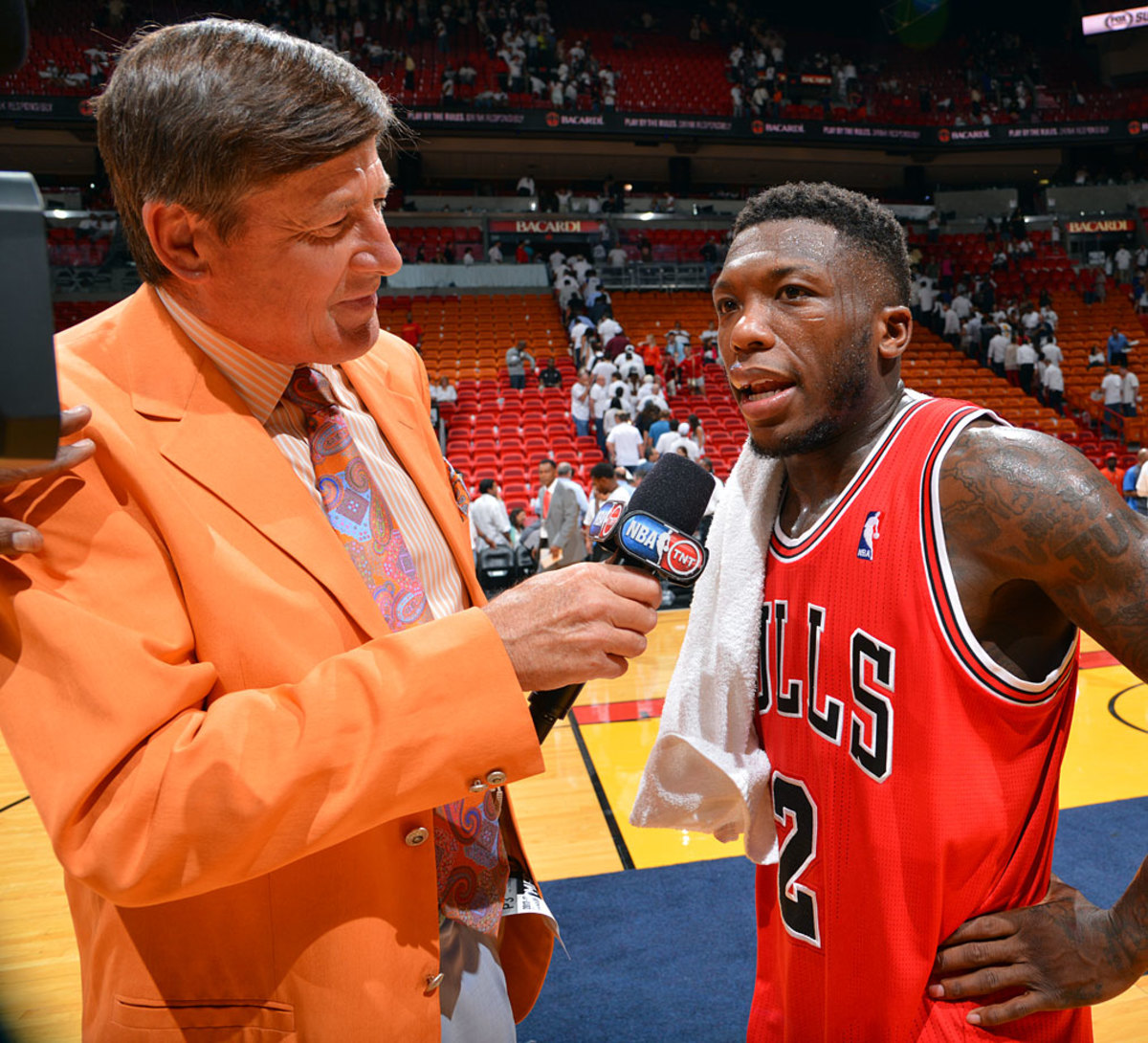
Craig Sager interviews Nate Robinson following the Chicago Bulls win over the Miami Heat in Game One of the Eastern Conference Semifinals on May 6, 2013 at AmericanAirlines Arena in Miami.
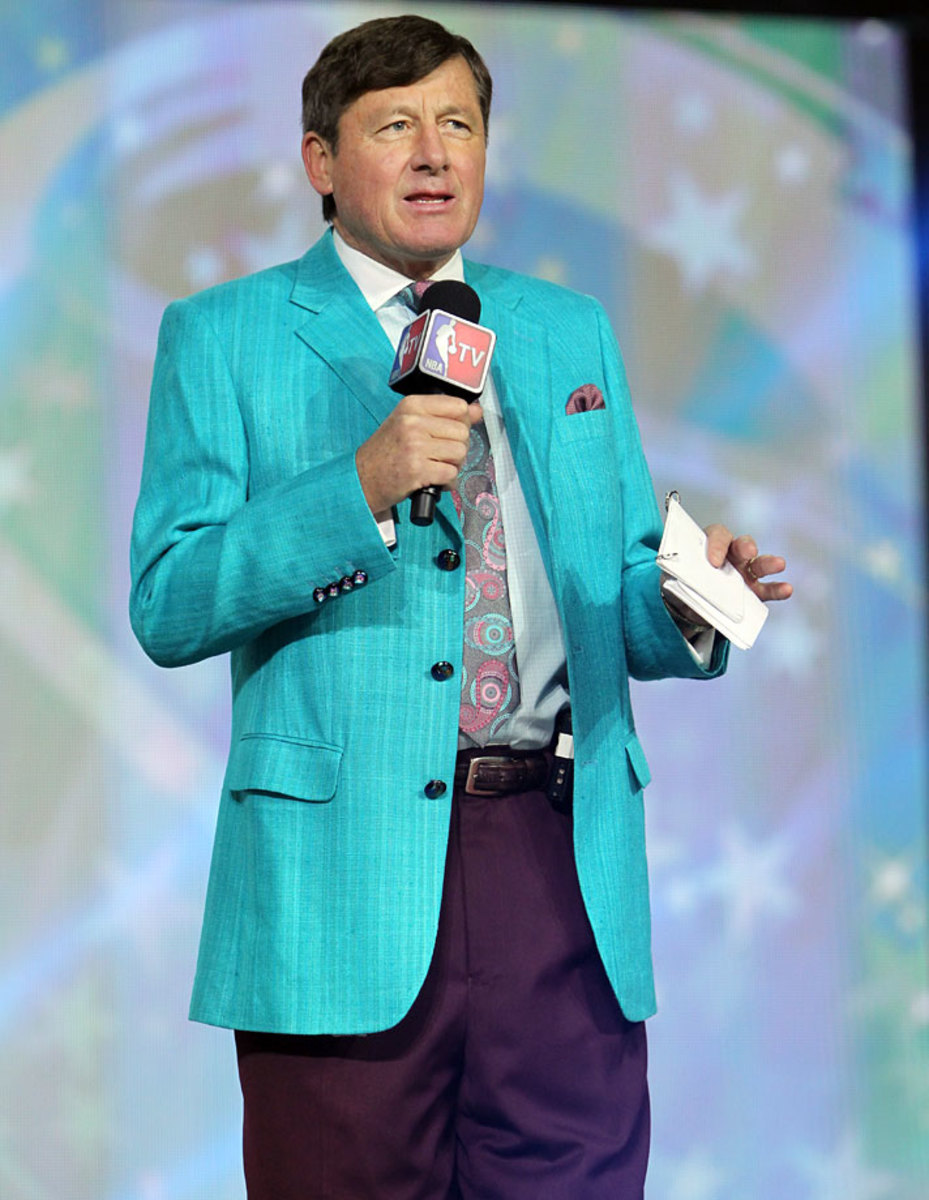
Craig Sager introduces the players during the NBA All-Star Practice on Feb. 16, 2013 at the George R. Brown Convention Center in Houston.
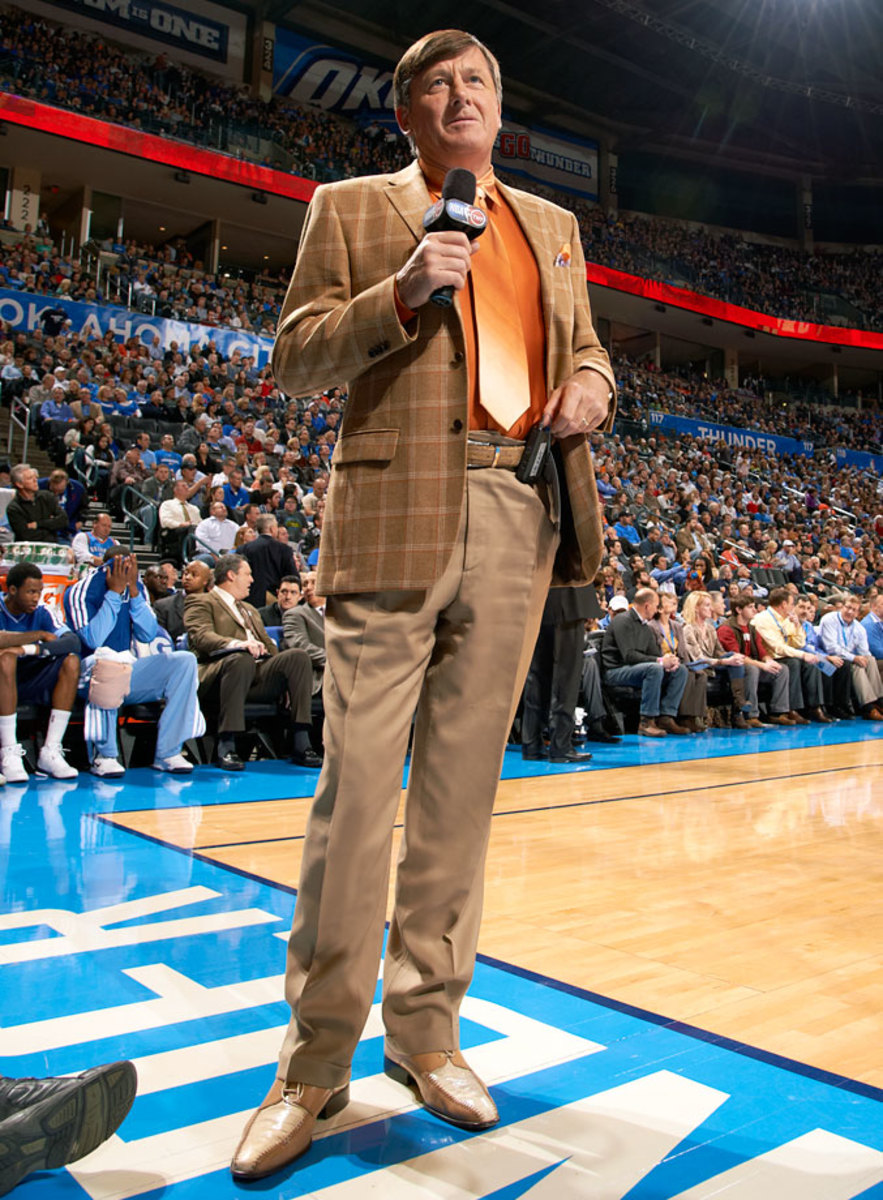
Craig Sager looks on during the Oklahoma City Thunder game against the Memphis Grizzlies on Jan. 31, 2013 at Chesapeake Energy Arena in Oklahoma City.
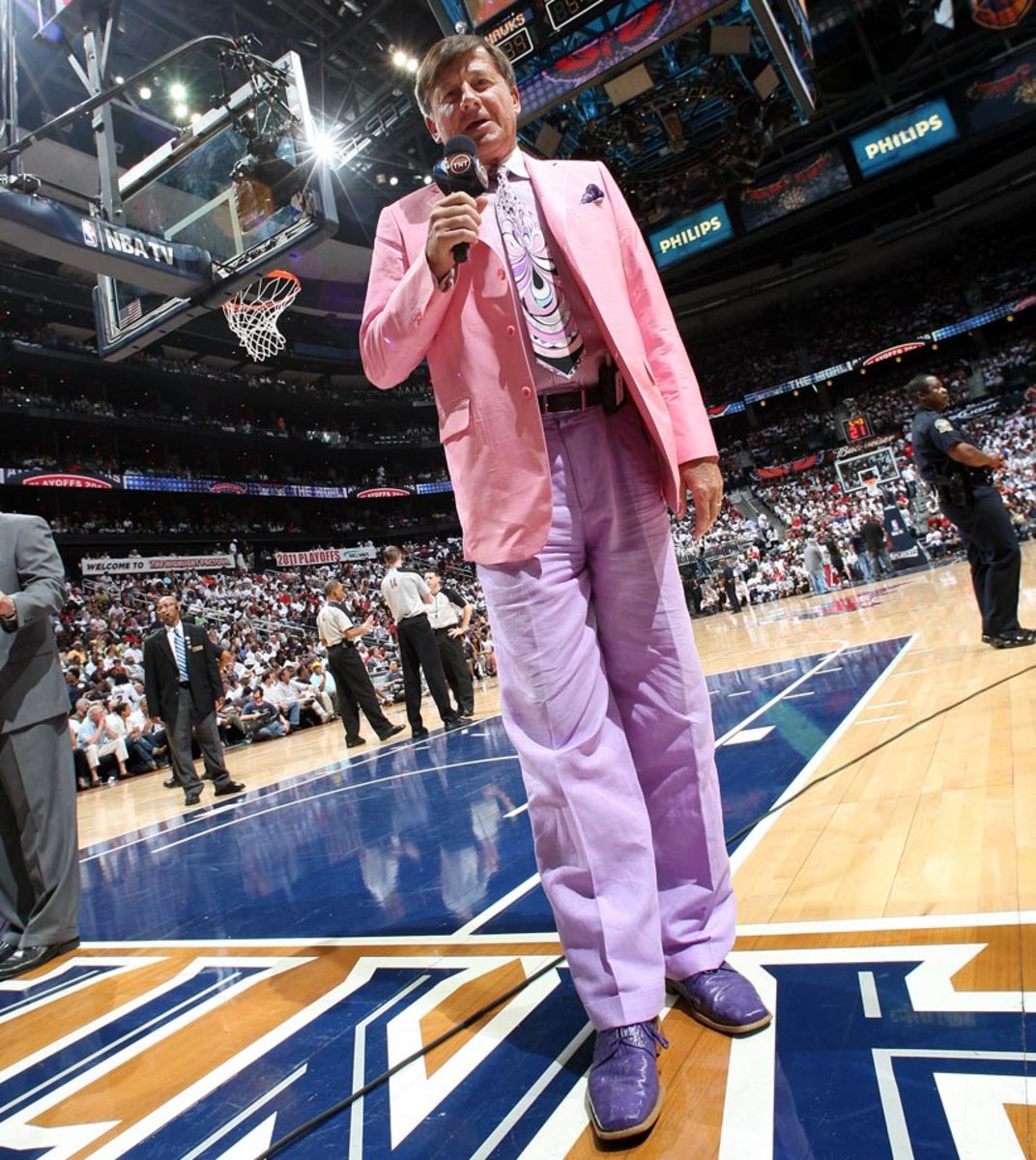
Craig Sager poses for a picture during Game Four of the Eastern Conference First Round between the Atlanta Hawks and Orlando Magic on April 24, 2011 at Philips Arena in Atlanta.
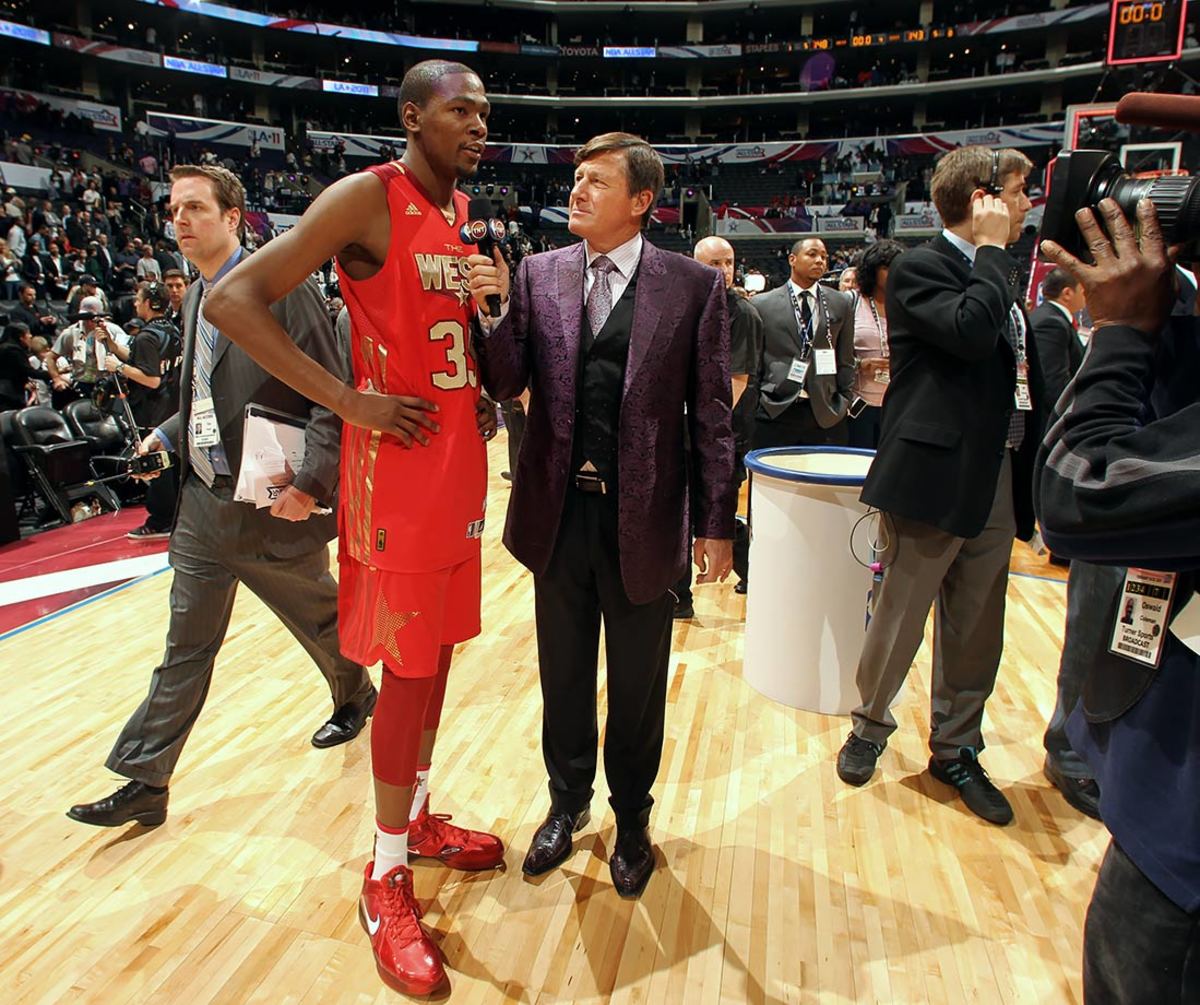
Craig Sager interviews Kevin Druant during the NBA All-Star Game on Feb. 20, 2011 at Staples Center in Los Angeles.
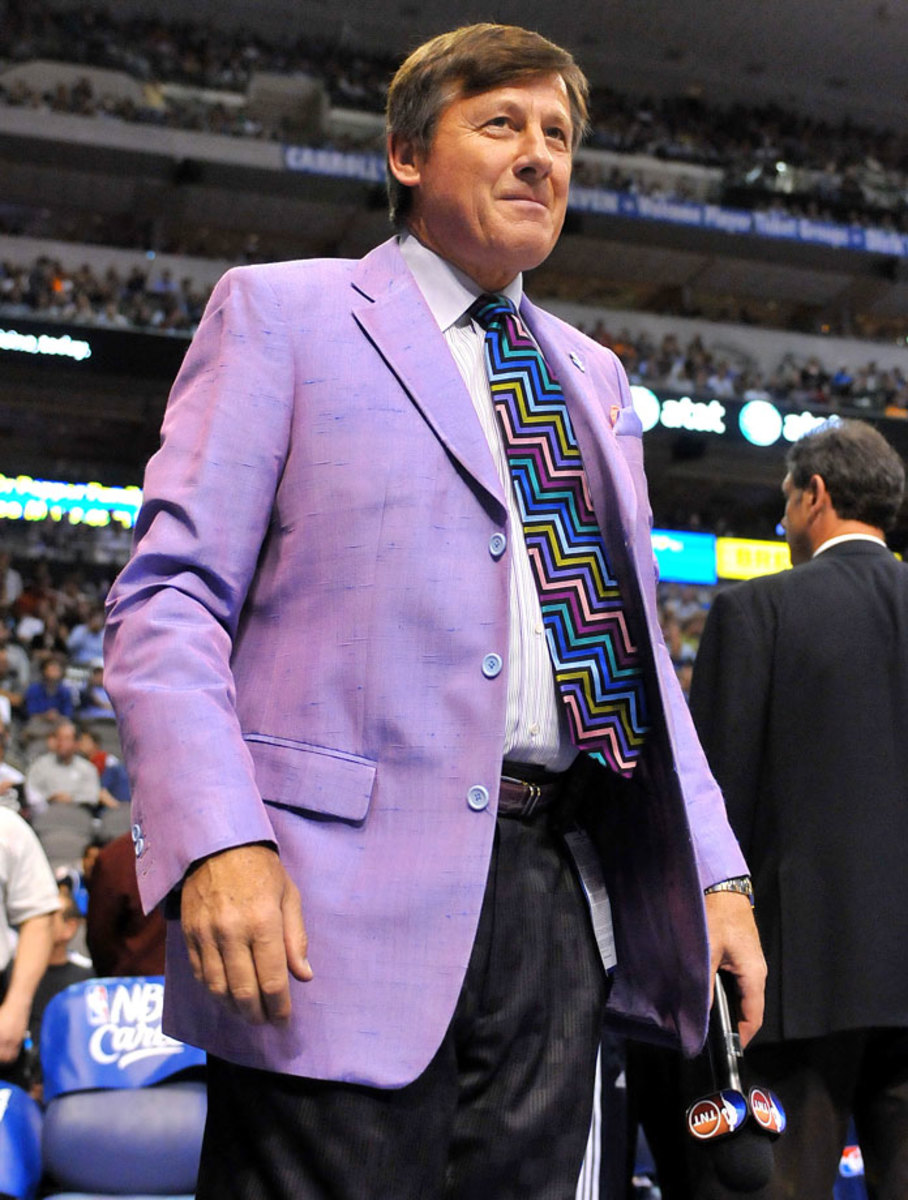
Craig Sager looks on during the Dallas Mavericks game against the Orlando Magic on April 1, 2010 at the American Airlines Center in Dallas.
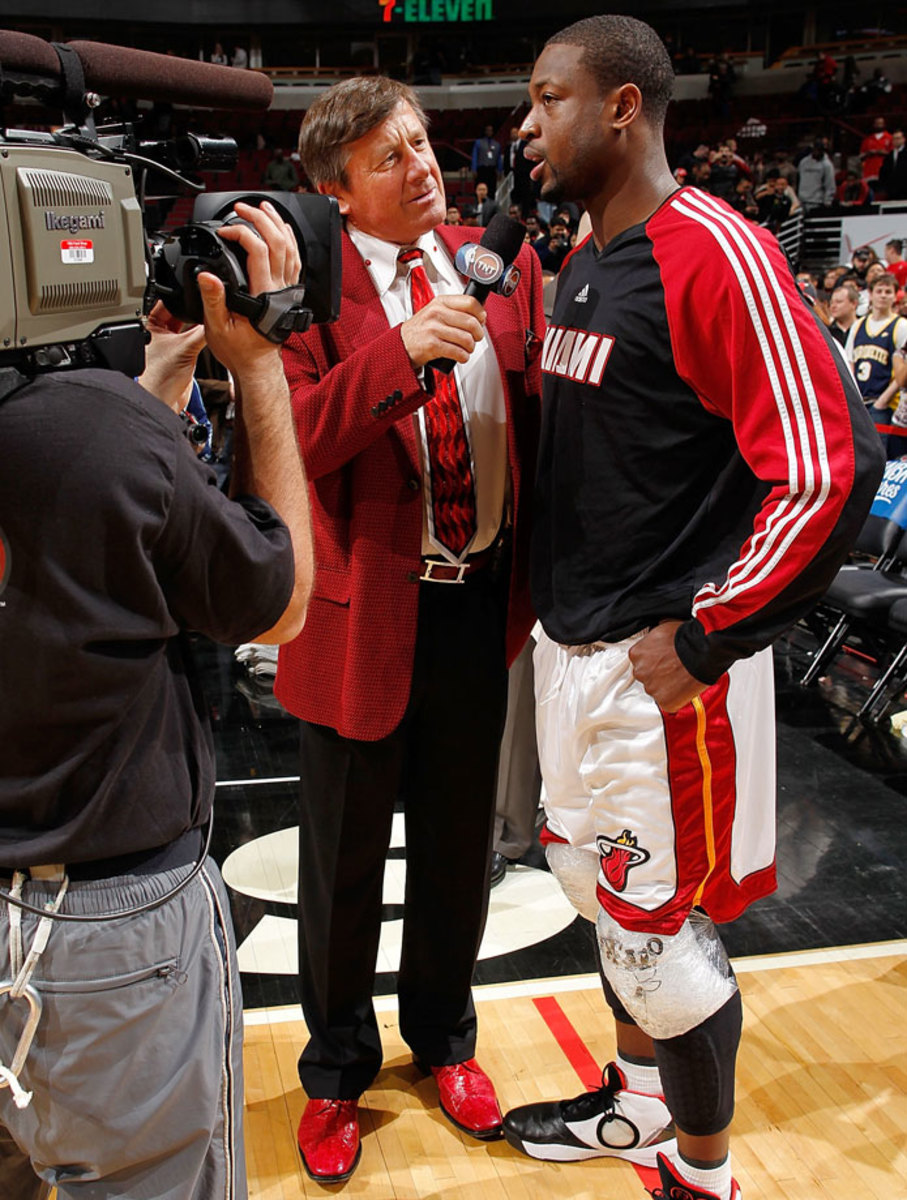
Craig Sager interviews Dwyane Wade following the Miami Heat's win over the Chicago Bulls on March 25, 2010 at the United Center in Chicago.
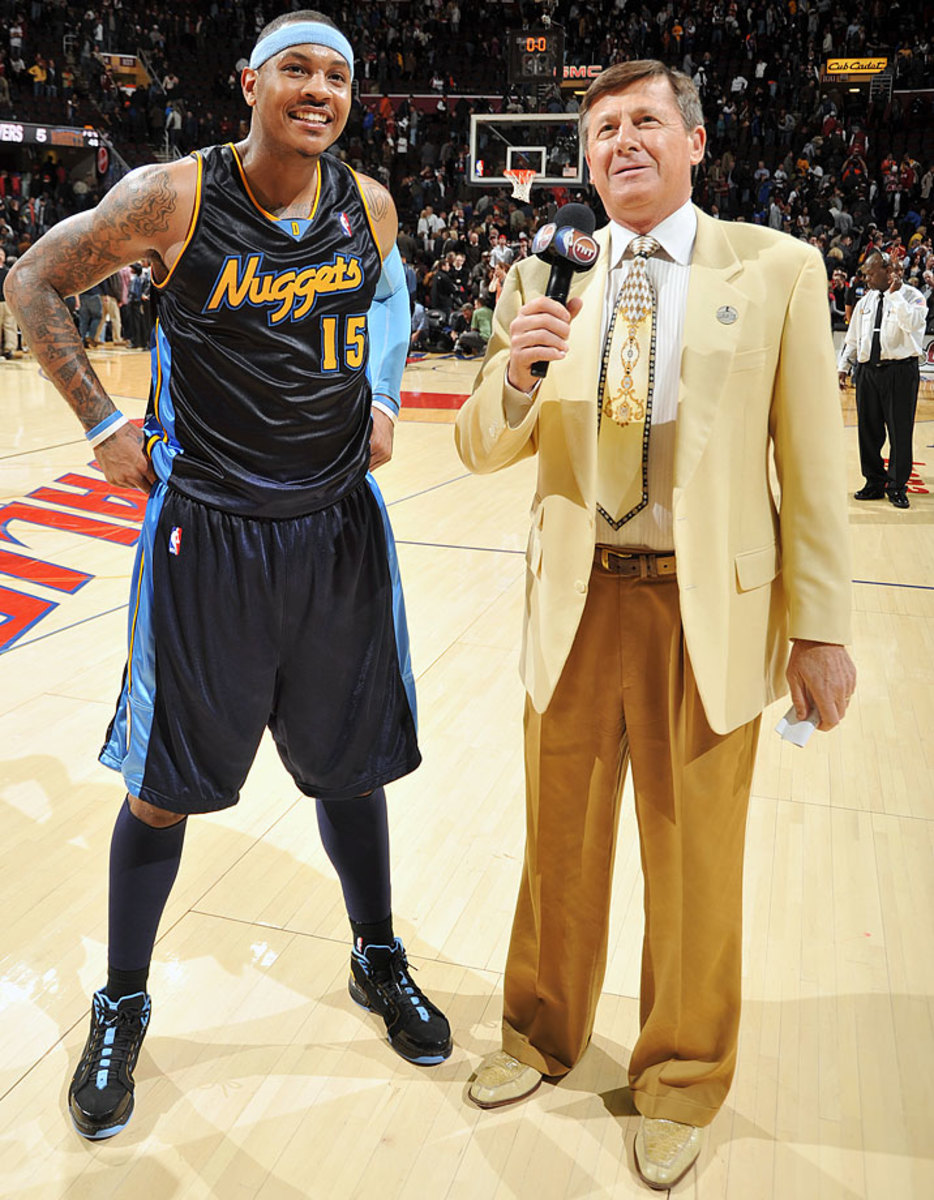
Craig Sager interviews Carmelo Anthony following the Denver Nuggets win over the Cleveland Cavaliers on Feb. 18, 2010 at Quicken Loans Arena in Cleveland.
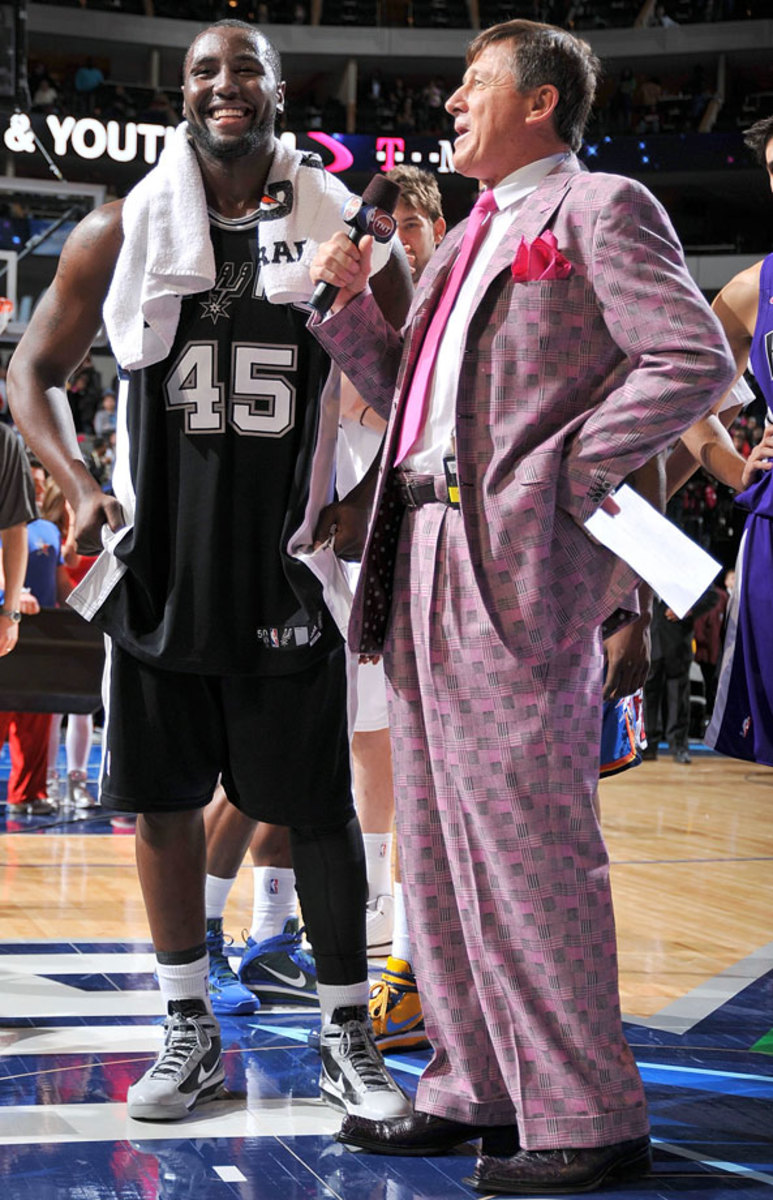
Craig Sager interviews DeJuan Blair following the Rookie Challenge part of NBA All-Star Weekend on Feb. 12, 2010 at the American Airlines Center in Dallas.
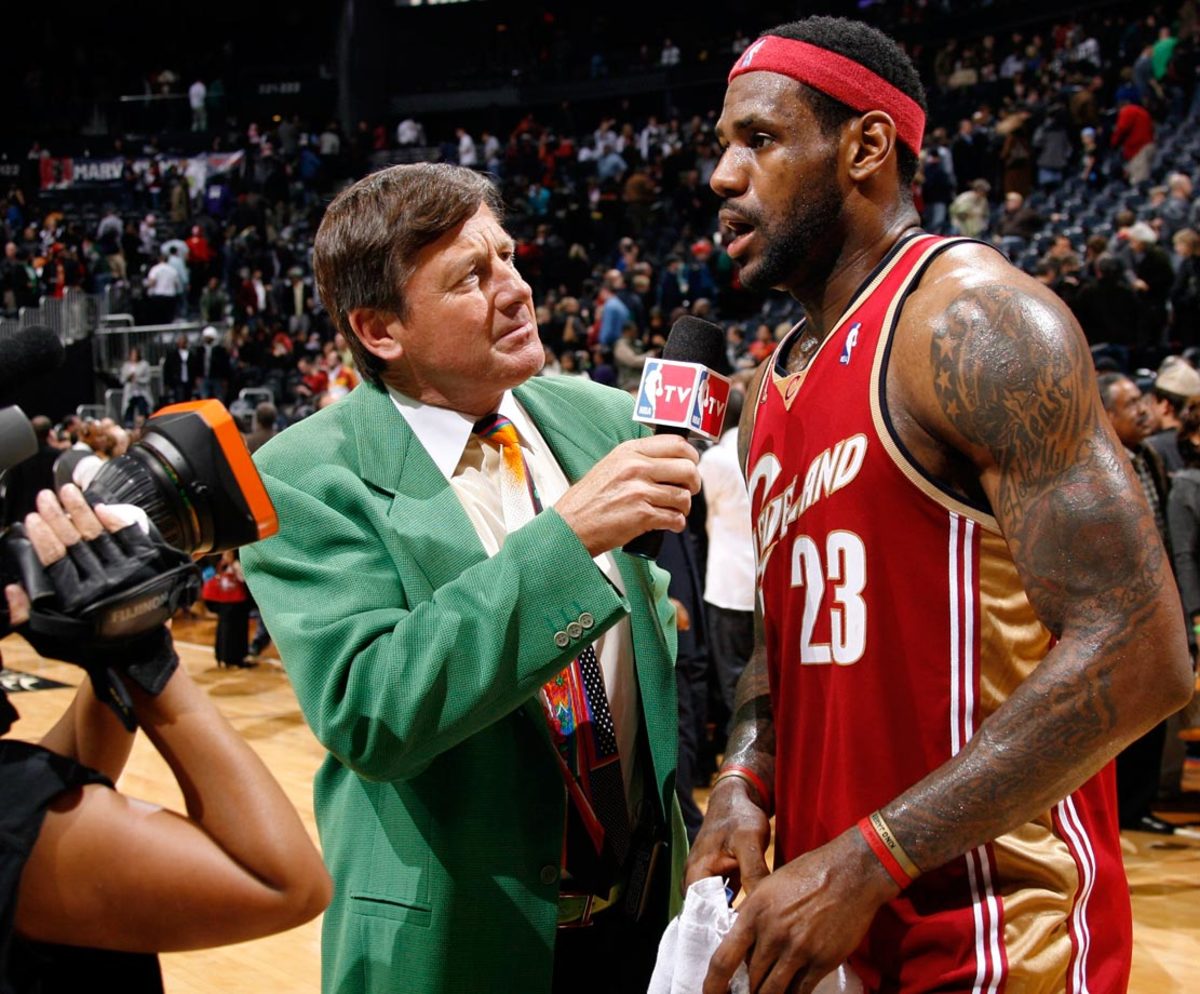
Craig Sager interviews LeBron James following the Cleveland Cavaliers win over the Atlanta Hawks on Dec. 29, 2009 at Philips Arena in Atlanta.
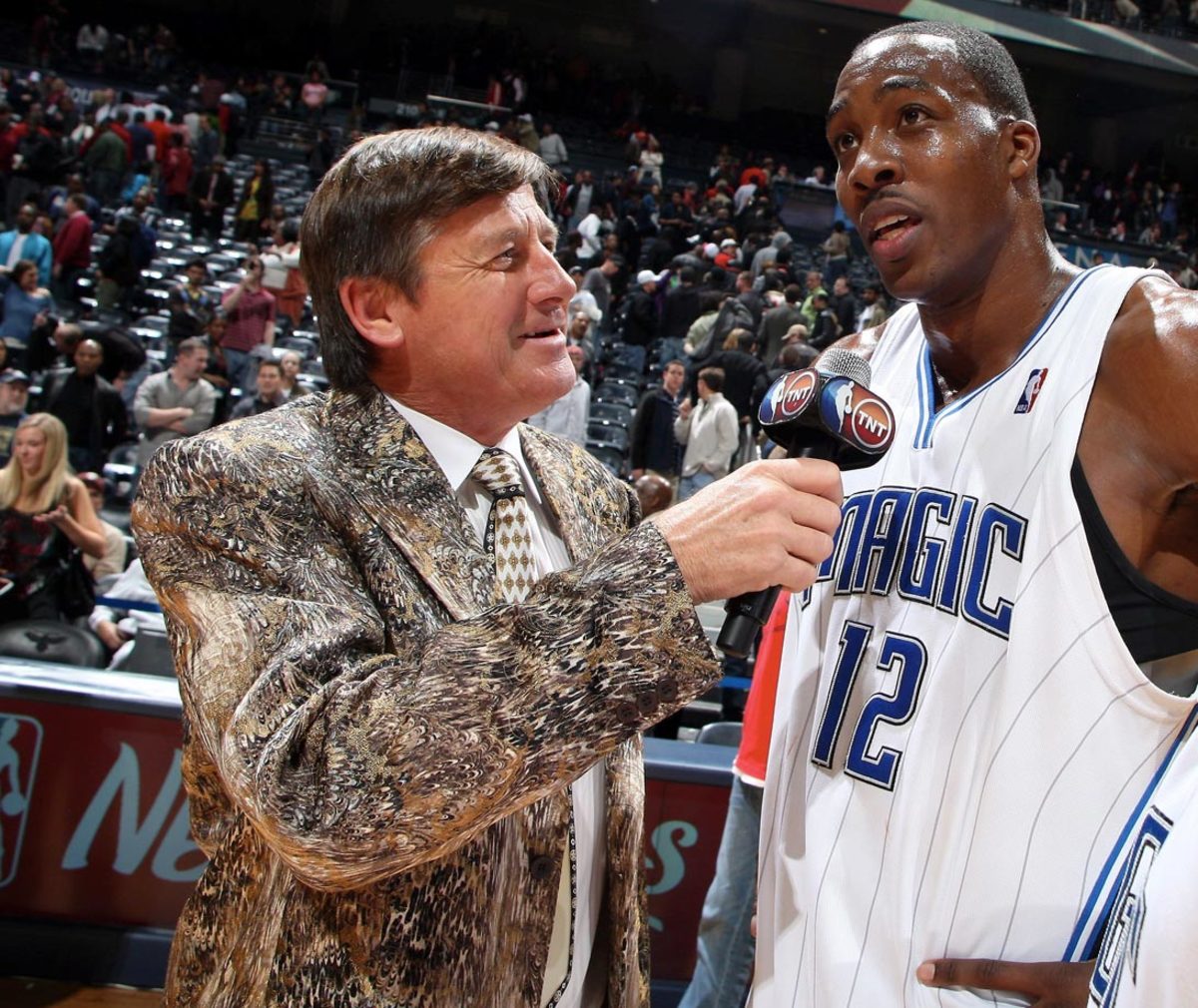
Craig Sager interviews Dwight Howard following the Orlando Magic's win over the Atlanta Hawks on Nov. 26, 2009 at Philips Arena in Atlanta.
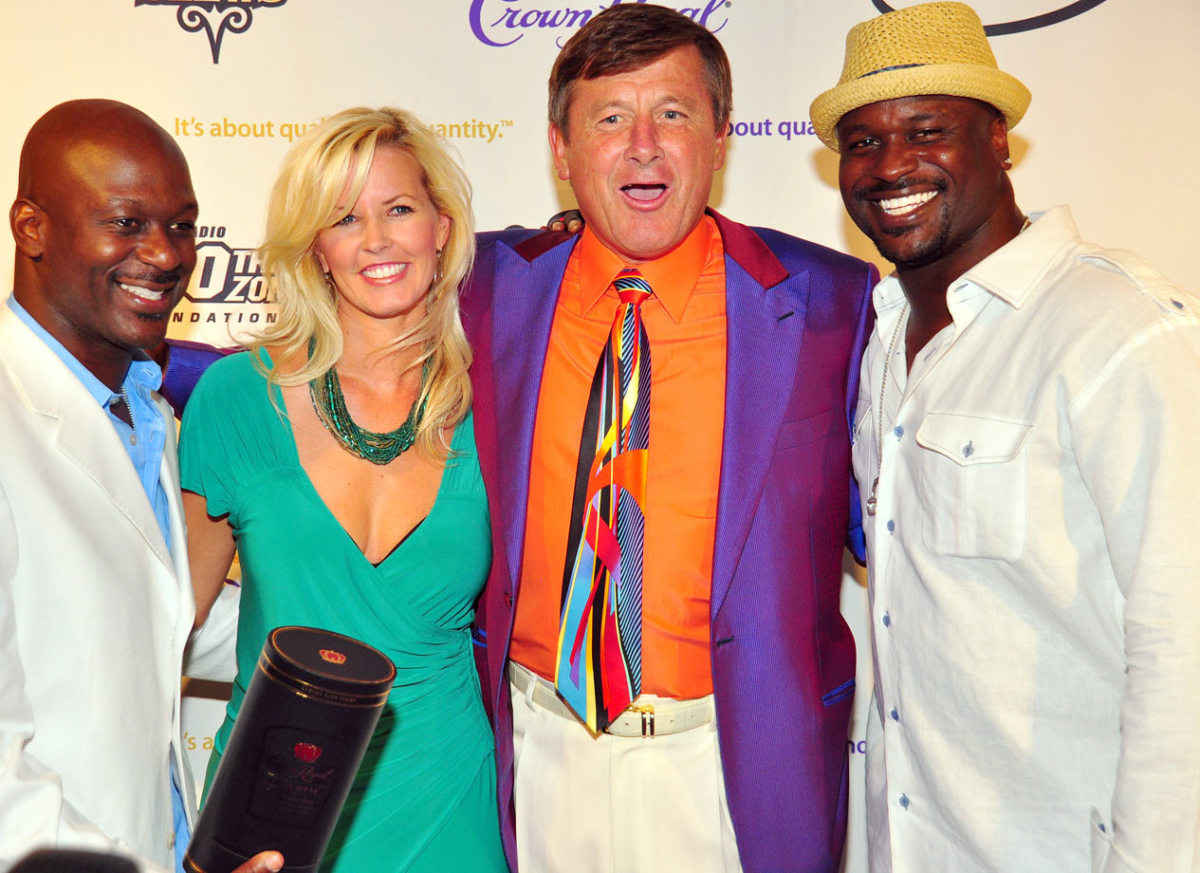
Craig Sager and his wife Stacy pose with Doug and Ryan Stewart at the Stewpendous Awards post-party on July 11, 2009 at the W Hotel in Atlanta.
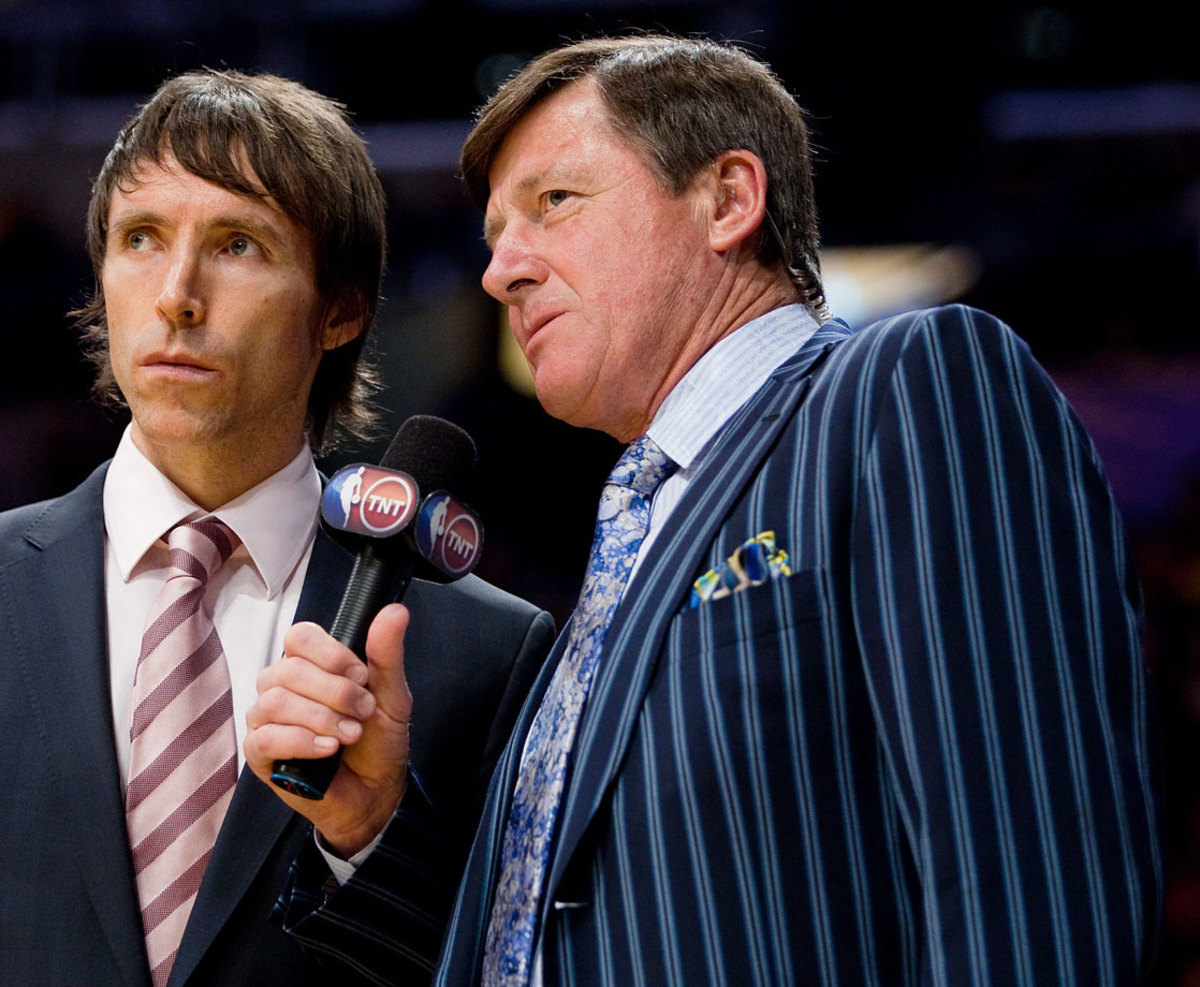
Craig Sager interviews Steve Nash during the Phoenix Suns game against the Los Angeles Lakers on Feb. 26, 2009 at Staples Center in Los Angeles.
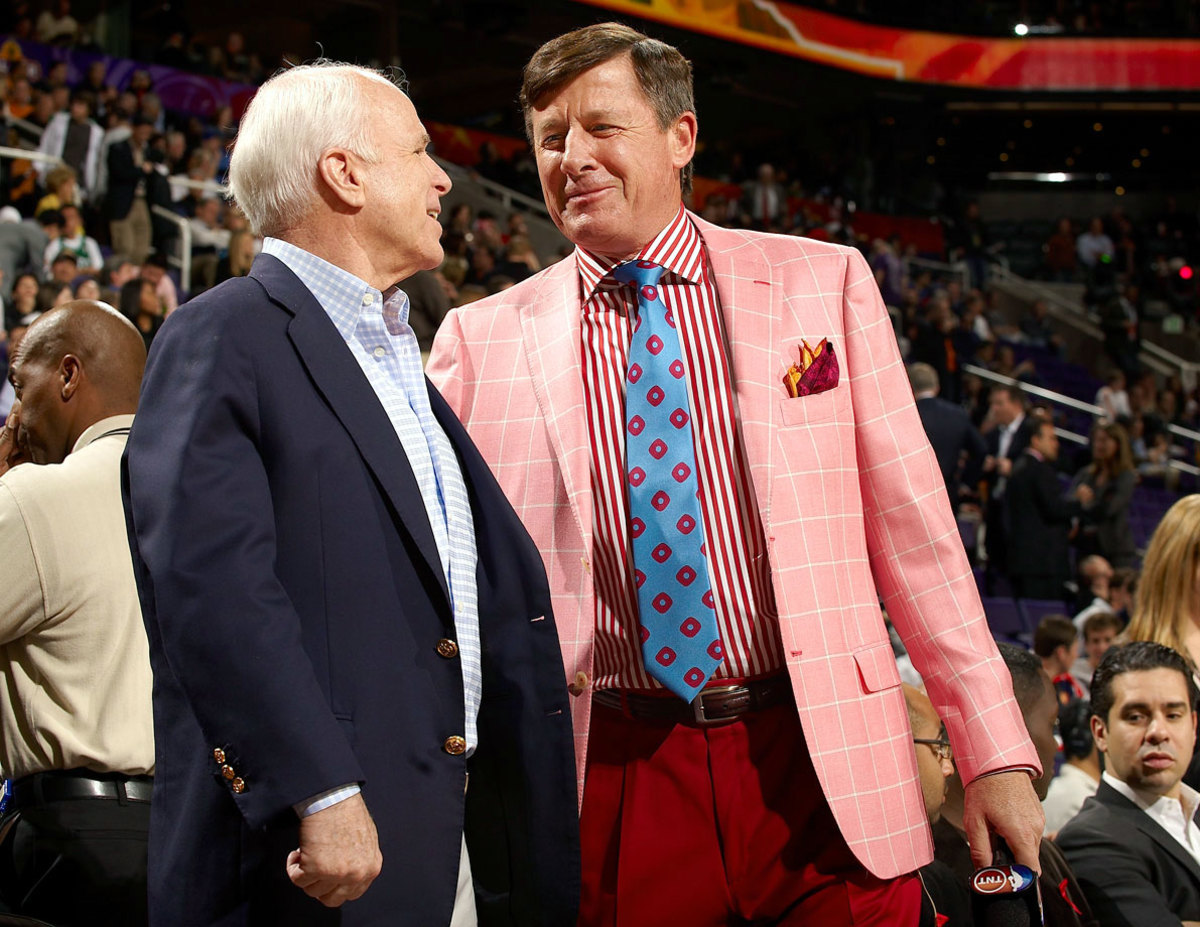
Senator John McCain chats with Craig Sager before the NBA All-Star Game on Feb. 15, 2009 at US Airways Center in Phoenix.
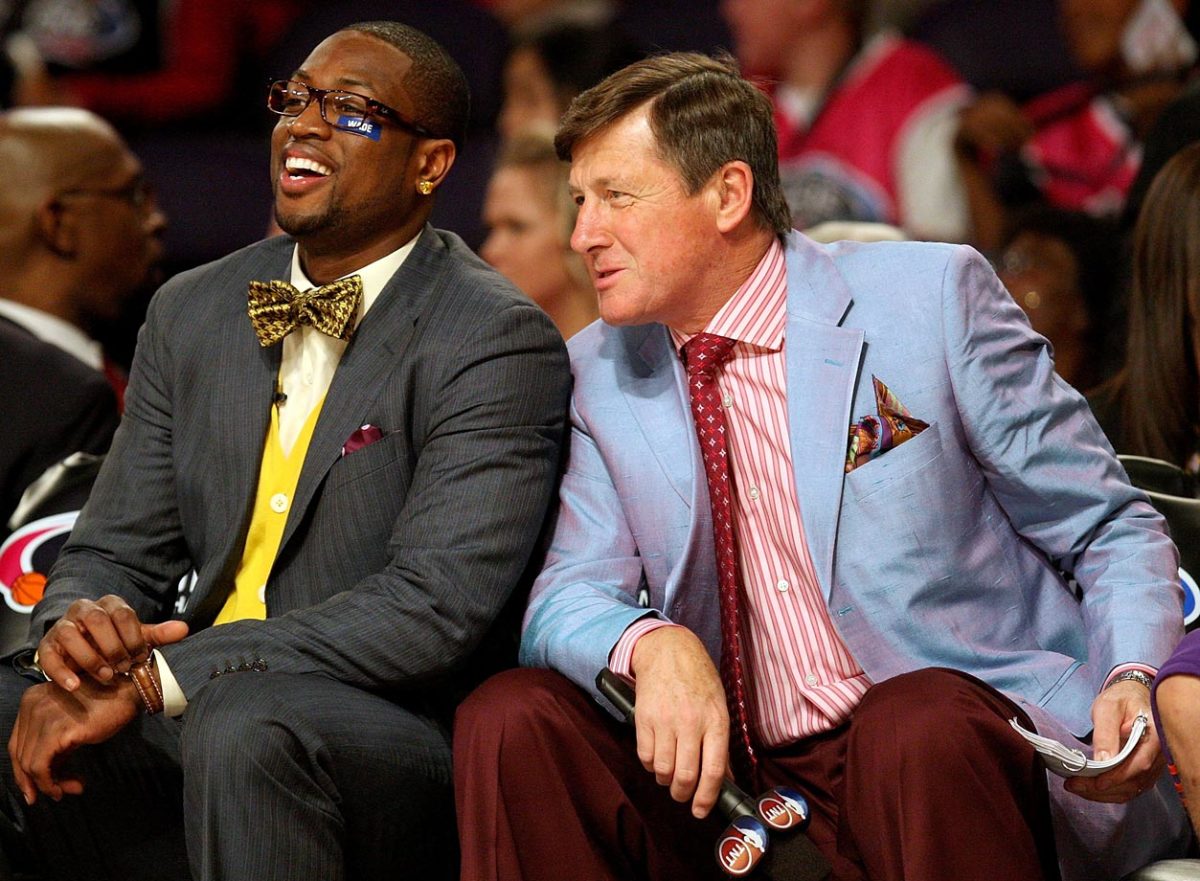
Rookie team assistant coach Dwyane Wade laughs alongside Craig Sager during the Rookie Challenge & Youth Jam part of NBA All-Star Weekend on Feb. 13, 2009 at US Airways Center in Phoenix.
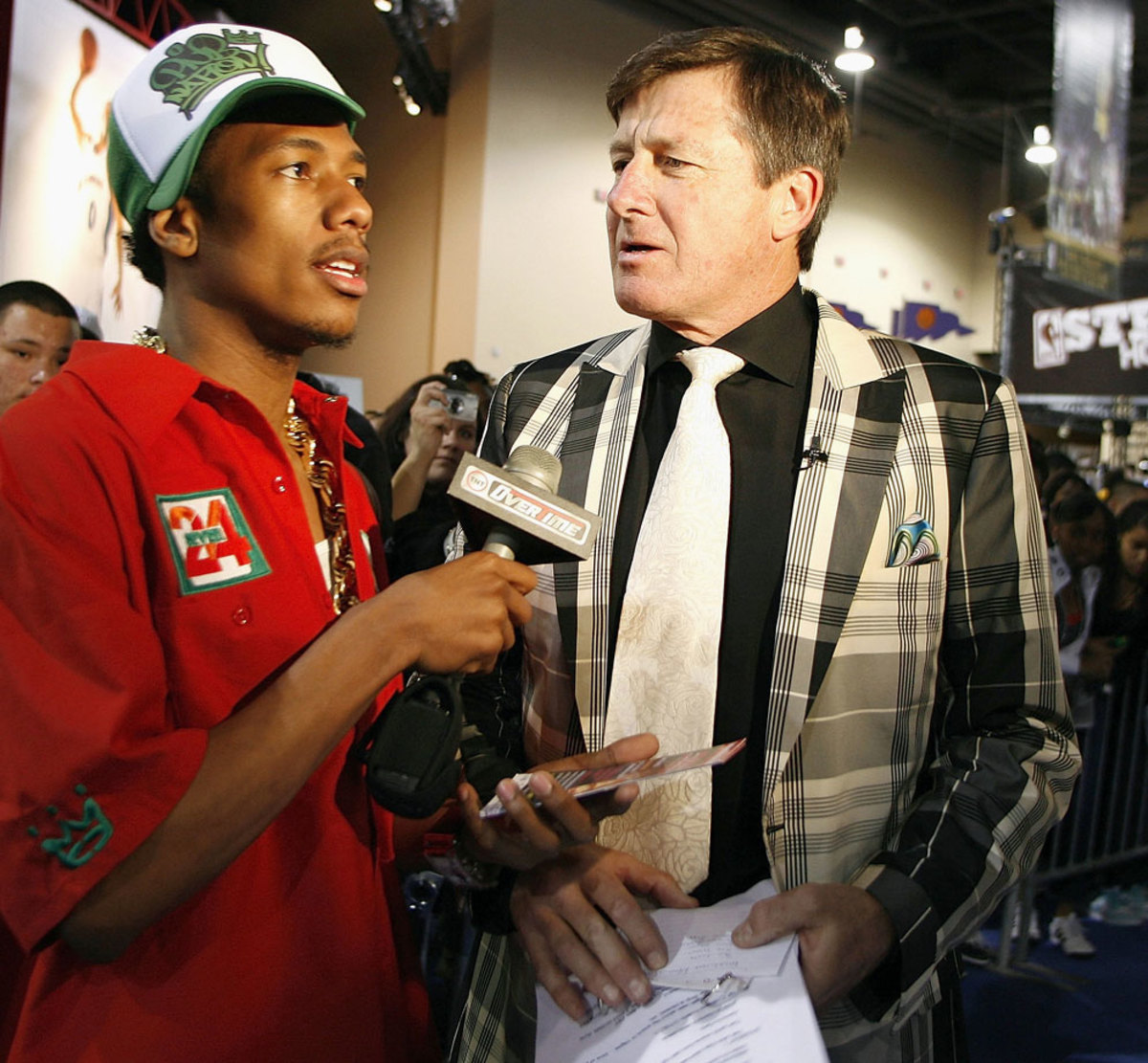
Nick Cannon interviews Craig Sager at Jam Session during NBA All-Star Weekend on Feb. 17, 2007 in Las Vegas.
Sager was diagnosed in April 2014 with acute myeloid leukemia, after he felt exhausted working a game in Dallas, and since then he has undergone two bone marrow transplants, 21 bone marrow biopsies and more than 20 chemo cycles—one that spanned two weeks for 24 hours a day. He has been hospitalized with pneumonia, influenza, C. diff (a bacterial infection) and gout. He has slipped out of remission twice, most recently in February, though he did not tell anybody for fear he’d get pulled off coverage of All-Star weekend. Sager still lives outside Atlanta, but he spends most of his time at the Marriott Medical Center in Houston, where he is in the midst of a clinical trial. Friends freaked in March when Sager told HBO’s Real Sports he had been given three-to-six months to live, but that was the prognosis for a patient without treatment, and he is receiving the best care available. “A patient who battles this past a year is amazing,” says his doctor, Naveen Pemmaraju. “What he’s done is almost miraculous.”
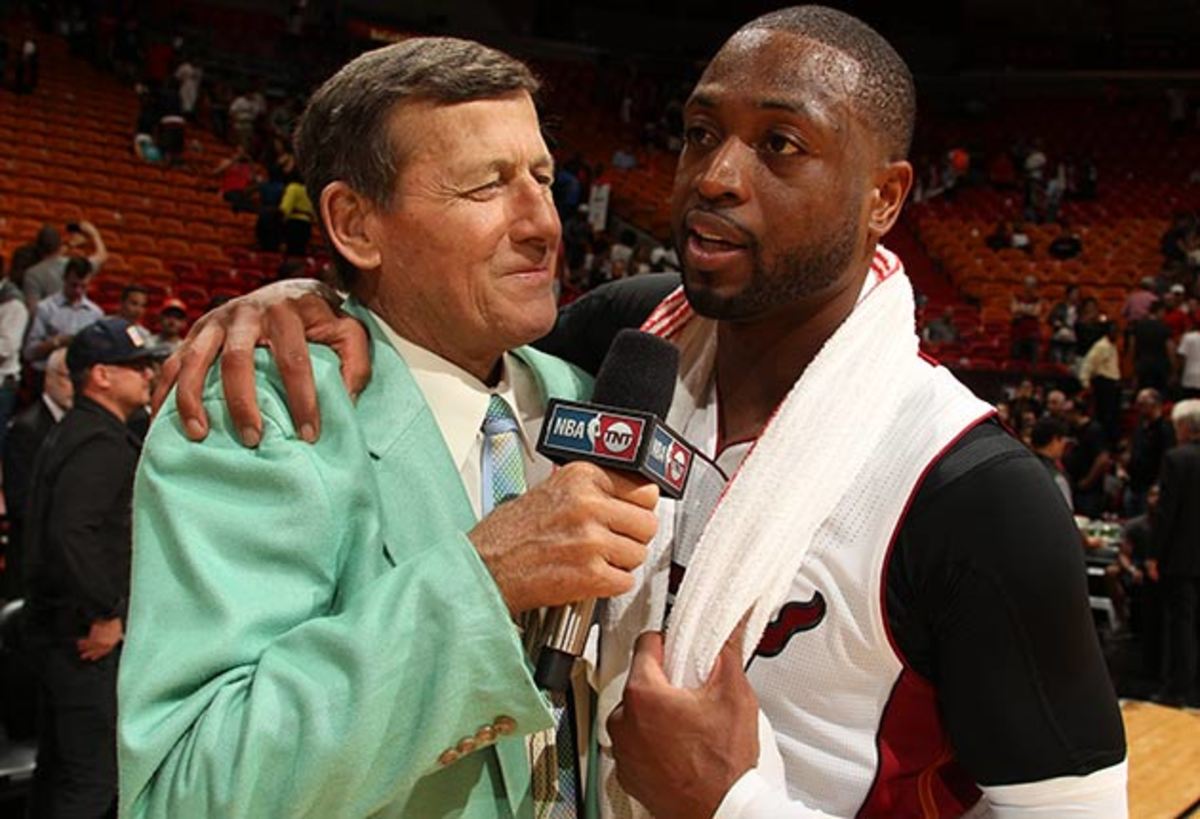
Another phenomenon, nearly as astonishing, has unfolded at the same time. The sideline reporter famous for being mocked by Garnett (“You take this outfit home and you burn it”) and stonewalled by Spurs coach Gregg Popovich (“That’s the stupidest question I’ve ever heard”) has become perhaps the most revered figure in the league. After the diagnosis KG sent the biggest bouquet. Pop sent the warmest note (“You could be on my team any day”). Commissioner Adam Silver came to visit. “You have bigger things to do,” Sager said.
“No, I don’t,” Silver replied. “You’re as important to the NBA as players or coaches or owners.”
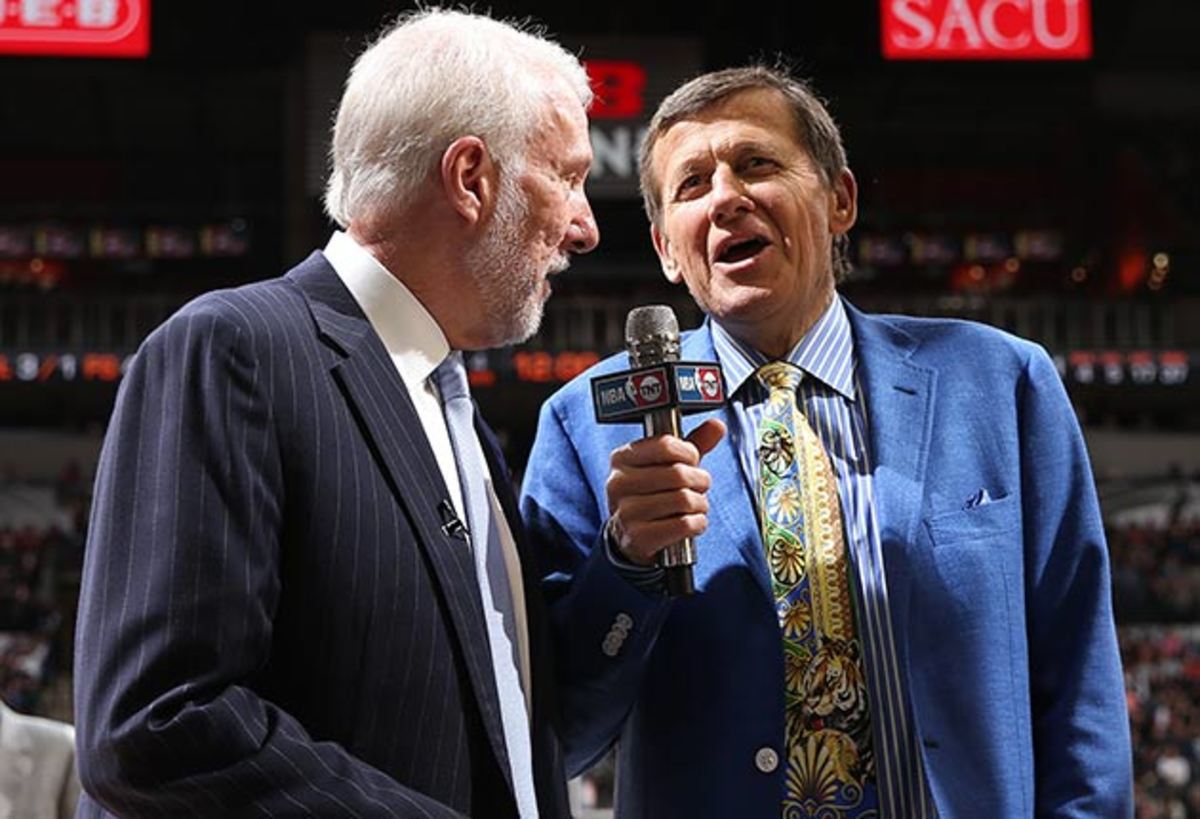
You can’t walk into an arena during a TNT broadcast without seeing sager strong signs. In the past month alone Rockets center Dwight Howard hosted a blood drive in Sager’s honor; Lakers sideline reporter Mike Trudell persuaded his counterparts across the league to don their most brazen attire for a night; and Warriors guard Steph Curry interrupted an interview with Sager—specifically, a question about fatigue—to point out the irony. “Seeing you and what you’re doing, we’ve got no excuses,” Curry said. “You’re an inspiration for us.” On April 20, Stacy attended the CancerCare gala in New York City, and the next morning she took a town car to LaGuardia Airport. The driver asked her to call Craig so they could pray together.
Sager writes the names and numbers of everyone who calls him on three-by-five index cards. He walks around with a stack. Rodman calls all the time. Karl Malone called. Phil Mickelson called. “I don’t really even know Phil Mickelson,” Sager says. “The response is so surprising to me.” It is not surprising to LeBron or Silver or Chris Paul, who has introduced Sager to his parents and in 2013 asked him to appear in one of his Jordan Brand commercials. “He gives everything realness,” Paul says. At some point Sager became part of the league’s fabric, double silk to be sure.
• MORE NBA: What Curry's knee injury means for Warriors and NBA
“As a player, you knew when he was in the building,” says Kenny Smith, analyst for TNT’s Inside the NBA. “And you knew, if Craig Sager was talking about you, that you were official. Your family taped it. You watched it over again. It was a validation.” Clippers coach Doc Rivers eyes rookies summoned for their first interview on Sagervision. “I know what they’re thinking,” Rivers says, “ ‘I just made the NBA.’ ”
In Detroit, Sager tried to call Matt Holsworth. Sager met Matt more than two years ago while reporting a feature on his daughter, Lacey, who befriended Michigan State forward Adreian Payne while suffering from fetal-nerve cell cancer. Lacey died at age eight. Sager thinks about her a lot. “I’m 64,” he says. “I’m lucky I’ve had such a full life, such a charmed life.” Sager’s father, Al, was a veteran who worked for Yank magazine (a World War II Army publication), produced The Army Hour radio show and wrote speeches for Richard Nixon on campaign stops in Illinois. Sager inherited his eloquence from his dad. But he got his spirit from his mom, Coral, who once grew so incensed over the officiating in one of his basketball games that she ran onto the court at West Aurora High. Police took her to jail.
• MORE NBA: Who should be Lakers next coach? | L.A.'s big mistake
Sager interviewed Hank Aaron on the field after his 715th home run. He broadcast Deion Sanders’s Pop Warner games in Fort Myers, Fla., when he heard the 12-year-old had talent. He assumed Popovich always considered him a nuisance, until they crossed paths in Puerto Rico during a 2003 USA Basketball Olympic qualifier, and Sager shared a piece of personal history. He was supposed to go to Air Force and play hoops for the Falcons. At the last minute his congressman redirected him to West Point, and he chose Northwestern instead. Pop and Sags could have been teammates in Colorado Springs.
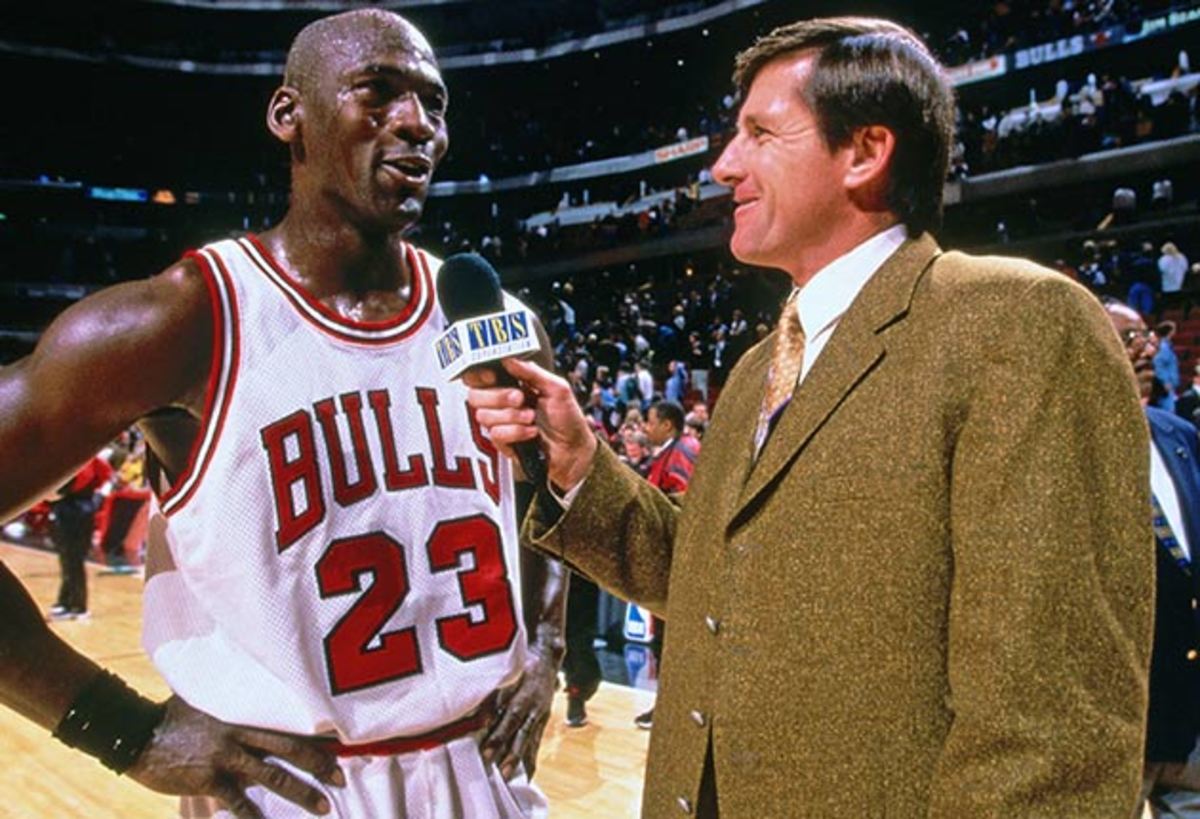
Sager has five children from two marriages: Kacy, 30; Craig Jr., 27; Krista, 24; Riley, 10; Ryan, nine. Stacy shares details of her husband’s condition that he will not. He’ll tell you, for instance, that he played 21 holes at Wildcat Golf Club in Houston last Friday. He won’t tell you that a friend accidentally rammed his cart, popping blood clots that sent him to the ER. “I don’t like to complain,” Sager says. “I don’t want people to go, ‘Look what happened to Sager, that’s so sad, that’s not the guy I knew.’ Then they won’t come see me.”
Sager’s visitors rarely catch him lying in bed. He stands for pictures. He combs his hair. His feet are swollen from the chemo, making his stingray loafers tight, so Nike sent him four animal-print sneakers modeled after Kevin Durant’s line. Emblazoned under one tongue is mr. fancy and under the other is suits. “You go in there trying to give him a lift,” says TNT’s Ernie Johnson, who beat non–Hodgkin’s lymphoma in 2006, “and you leave all fired up.” Sager’s gear helps him stand out in a crowded field and break the ice with chilly subjects. But that’s not why he buys it. He doesn’t have a stylist or a clothing allowance either. “I just like it,” he says. “I feel comfortable in it. It all looks good when I pick it out.” He cares less about fashion than color. In Fort Myers he delivered pep rallies while decked out in school colors: Fort Myers High green, Cypress Lake purple, Riverdale maroon. He often takes notes with colored ballpoint pens, using purple ink for the Lakers, red for the Rockets and so on. His former producer D.T. Slouffman once asked Sager to sign a baseball for his daughter’s fourth birthday. He knew her favorite color was pink. “To Holly Anne,” Sager wrote. “Happy Birthday Let’s Party! You Wear Pink I’ll Wear Purple. Your Daddy’s Friend, The Man In The Funny Coats.” The message included both pink and purple ink.
He is still that color man, even if the coats are a few sizes smaller. But why in the world is he in Detroit, working a predictable first-round series, when his platelets are at four and his hemoglobin is falling and a paper cut could do serious damage? “What do you mean?” Sager asks. He sounds like Pop, rejecting the premise of the question, that there is such a thing as an insignificant assignment. “But it is the essential question,” says Pemmaraju, his doctor. “What he’s doing has danger. It has risk. Then again, we talk a lot about the mental aspect. Where do you go for your inspiration, for your drive? For him, it’s this job. If he can’t do it, then that could be harmful too.”
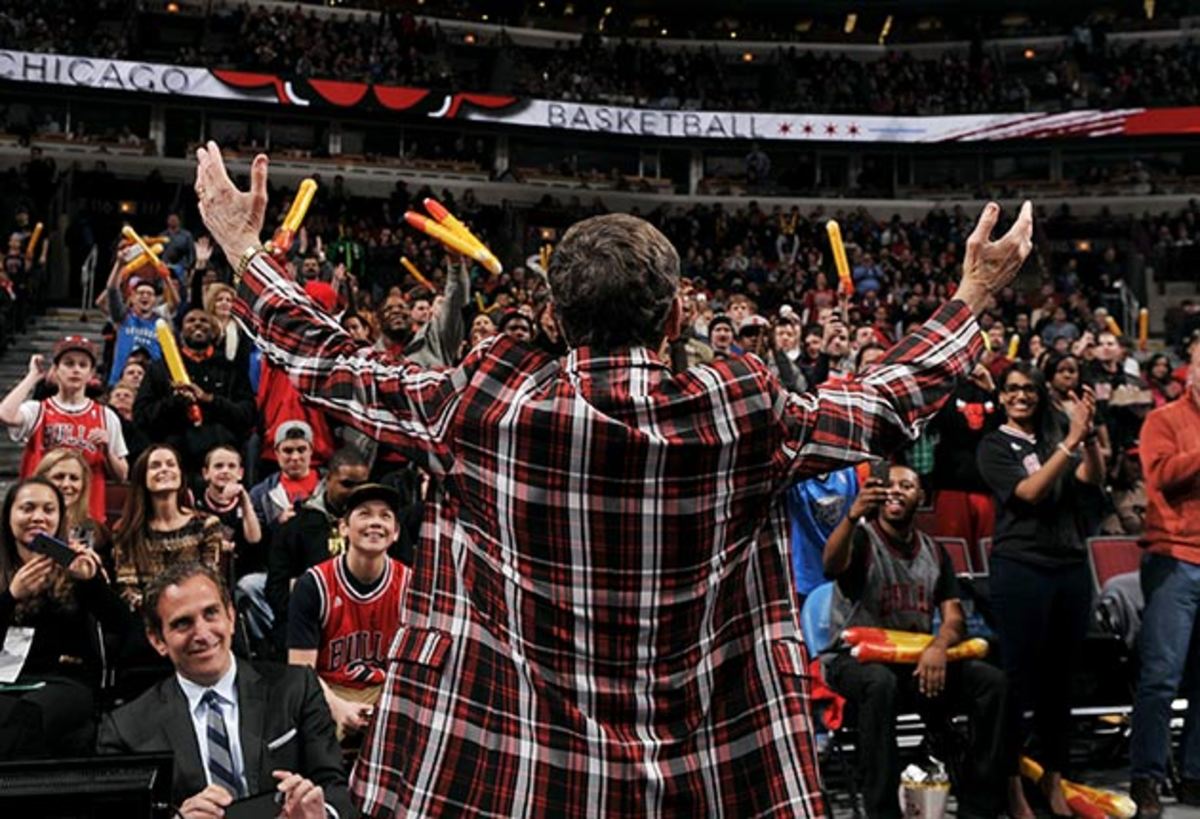
Sager and Pemmaraju are hoping that the clinical trial—a combination of chemotherapy and immunotherapy—puts him back in remission and eligible for a third bone marrow transplant, not unprecedented but extremely uncommon. Craig Jr. donated his marrow for the last two procedures, which were successful, though not lasting. “Am I naive?” Sager says. “Maybe. Am I in denial? No. I know the severity. But I have faith. I have support. I have hope. Hope is as important as breath.”
By Sunday afternoon Sager is bored in the hotel. He can’t reach Matt. He can’t take his usual trail run. He waits impatiently for Game 4, followed by a flight to Atlanta on Monday morning and a blood and platelet transfusion. Sitting there with another IV in his arm, he finally hears from Matt, who was in Hawaii to mark the two-year anniversary of Lacey’s passing. “I was getting worried,” Sager says. He is relieved.
“I call him the Miracle Guy,” says Bruce Teilhaber, owner of Friedman’s Shoes in Atlanta, which sold Sager his vibrant kicks for nearly three -decades—alligator and crocodile, lizard and snake, pink and peach, bloodred and money-green. The size 12s were for Sager. The size 22s Sager delivered to Shaq.
“All I want,” Teilhaber says, “is to sell that Miracle Guy another pair of purple shoes.”
